Here are the full time tests performed by P. Julian Maddock for the defence. The document is provided at the bottom of this page, courtesy of John Gannon. Please alert me in the comments if I have made any mathematical errors.
Full Transcript
(Cover)
Dated 16th. April 1931.
To Messrs.Herbert J Davis, Berthen & Munro,
36, Dale Street,
Liverpool.
THE KING v. WALLACE.
REPORT
– by –
P.Julian Maddock.
20, Lord Street, Liverpool.
(1)
To Messrs.Herbert J. Davis, Berthen & Munro,
Solicitors.
36, Dale Street, Liverpool.
Re THE KING v. WALLACE.
REPORT by P.Julian Maddock, Civil and Consulting Engineer, of 30, Lord Street, Liverpool.
In an interview with your Mr. Munro on March 23rd 1931 I was informed of the relevant points with regard to the times and distances involved in Mr. Wallace’s journey from his house 29 Wolverton Street to the City Café, North John Street, Liverpool, on the night of January 19th.1931, of his journey from his house to Menlove Gardens West etc. and return to his house on the night of January 10th.last and of the journeys of various Police witnesses over part of the same route on various subsequent dates, and I was asked to check such times and distances and to report thereon.
I have been supplied with a copy of Phillips’ Map of Greater Liverpool (uncoloured edition) which has been published recently, on which the tram route to the City Café taken by Mr. Wallace on January 19th. is shown in green and the tram route taken by him to Menlove Gardens West on the night of January 10th. is shown in red.
I have to point out here that in my opinion his map is not at all reliable. The fact that Wolverton Street itself (which obviously has been in existence many years) is not shown on the map at all and, that Castlewood Road
(2)
is still named Caborne Road, should be sufficient proof that this opinion is justified.
I have perused copies of extracts from evidence given in the Police Court proceedings as follows:-
William Henry Harrison, Surgeyor. Feb.19th.1931.
Thomas Charles Phillips, Tram Con. Feb.20th.1931.
Arthur Thompson, do. Feb.20th.
Katie Mather, Occupier 25 Menlove Gardens West, Feb.20th.
Janes Edward Serjeants, Police Constable, Feb.20th.
Lily Pinches, Manageress, Feb.20th.
Sydney Hubert Green, Clerk, Jan.20th. ?
Adolphus Fothergill, Detective Sergeant Undated.
William Prendergast, Police Constable do.
James Reginald Hill, Det.Sergeant. March 3rd.
William Brown Gilroy, Det.Constable, March 3rd.
Walter Stanley Oliver,Det Constable, March 3rd.
Lily Hall, Typist, Feb.20th.
Henry Bailey, Det.Sergeant, March 3rd.
Herbert Gold, Det. Inspector. March 4th
I have also perused your letter of March 27th.1931 with referece to Mr.Wallace’s journey from his house to the City Café on January 19th. last.
I have carefully examined the district around 29 Wolverton Street and have gone over the routes to the City Café and to and from Menlove Gardens West, I have also checked the distances given in evidence.
I have to report as follows:-
Wolverton Street is about 100 yards long and runs in a North Westerly direction from one branch of Richmond
(3)
Park. Richmond Park is a street of L shape, one portion running in a North Westerly direction to Breck Road, Anfield, and the other portion running in a North Easterly direction to Lower Breck Road. Wolverton Street runs off this latter portion.
By inspection on the ground and of the 25th.Ordnance Map Lancs. OVI.7, it would appear that between Lower Breck Road and Belmont Road the land has been developed for building purposes in at least two estates without any regard for communication in a North East, South West direction, as there is a dividing line commencing at Breck Road, Anfield, at the Rawdon Free Library and running in a South Easterly direction to the Boundary of the Belmont Road Institution.
I am unable to find any communication for vehicular traffic through this line and the only communication for pedestrian traffic, so far as I have been able to discover, is through a narrow, dark and dangerous passage running alongside the New Institute in Richmond Park and leading out into the corner of Sedley Street which is also an L shaped road.
This passage I understand is the one used by Mr. Wallace on January 20th. on his way to and from Menlove Gardens West and by various police witnesses when taking the time occupied on a journey from Wolverton Street to Smithdown Lane.
The Wolverton Street district contains quite a number of narrow passages which are very much used as means of access to and from the various streets which have been laid out in a very inconvenient manner.
(4)
Considering first Mr.Wallace’s journey from his house to the City Café on the eveing of January 19th.
I have tried various alternative routes from the back door of the house to the tram route along Breck Road and have come to the conclusion that the shortest and most direct way is to go along the back passage in a N.W. direction, turn left along a passage into Richmond Park along the boundary of a large house (which I am informed is known as Richmond House), turn right along Richmond Park to Breck Road, Anfield. There is a request tram stop and the end of Richmond Park.
The distance from the house to this point is 243 yards. If there was a tram available at this point at the time it would be possible to board it there. If not one would turn left up Breck Road Anfield rowards Belmont Road and on the way would pass a compulsory tram stop at the end of Newcombe Street.
This point is 400 yards from the house.
If there were no tram available at this point one would continue along Breck Road to the junction of Belmont Road. This point is 533 yards from the house.
I understand this was the route and distance walked by Mr. Wallace on January 19th. according to his own statement, and also that he then boarded a Church Street car and proceeded to North John Street and the City Café.
I repeated this journey on Wednesday April 8th. last with the following result:-
(5)
| Test A. | Time on Journey. | Time Waiting. | |
| Left 29 Wolverton St. | 4.16 p.m. | ||
| Arrived Belmont Road Junction | 4.21.20 | 5M. 20S. | |
| No.14 Car arrived | 4.25.10 | ||
| ” ” ” departed | 4.25.20 | 4 min. | |
| North John St. arr. | 4.42.30 | 17M. 10S. | |
| Walked to City Café arr. | 4.44 | 1M. 30S. | |
| Total | 24 min. | ||
| Add | 4 min wait | ||
| 28 |
Test B.
On April 9th I again travelled from Belmont Road to the City Café in North John Street.
| Time on journey. | |
| No.14 Car. Belmont Road dep. 5.26.40 | |
| North John St. arr. 5.43.30 | 16 M. 50 S. |
| Walk to City Café arr. 5.45 | 1 M. 30 S. |
| (It will be observed that there is only 20 seconds difference between the two tram journeys. It may therefore be taken that this takes about 17 minutes.) | |
| Walking time to Belmont Road about | 5 minutes |
| Walking time North John St. to City Café | 1 min. 30 sec. |
| Total | 23 min. 30 sec. |
This is the shortest possible time and assumes fair walking pace and that a tram is available immediately on arrival at Belmont Road.
With regard to possible waiting time it will be observed that on my Test A. this amounted to 4 minutes which added to the above average time of 23 min. 30 secs.
(6)
would bring the total up to 27 mins. 30 secs.
I am informed officially by Mr.Priestley, General Manager of the Liverpool Corporation Tramways, that on January 19th. last between the hours of 7.0 p.m. and 8.0 p.m. the only cars running from Belmont Road via Church Street to Pier Head were the No.14 cars and that the intervals between cars would be 8 to 9 minutes.
(At this date owning to the Tunnel subsidence under Dale Street, the No.13 cars via Dale Street and also some of the Church Street cars [to the East of where Whitechapel meets Lord Street] were diverted via Gt. Crosshall Street and Whitechapel and some ran to Victoria Street. These would presumably take longer on the journey.)
William Herbert Wallace: “When I left home of Monday night to go to the Chess club I think I walked along Richmond Park to Breck Road and then up to Belmont Road, where I boarded a tram car and got off at the corner of Lord Street and North John Street.”
From William’s tram stop, the club should be reachable within 50 seconds to 1 minute 10 seconds (4 vs. 3 mph walking speed), plus some seconds to depart the tram.
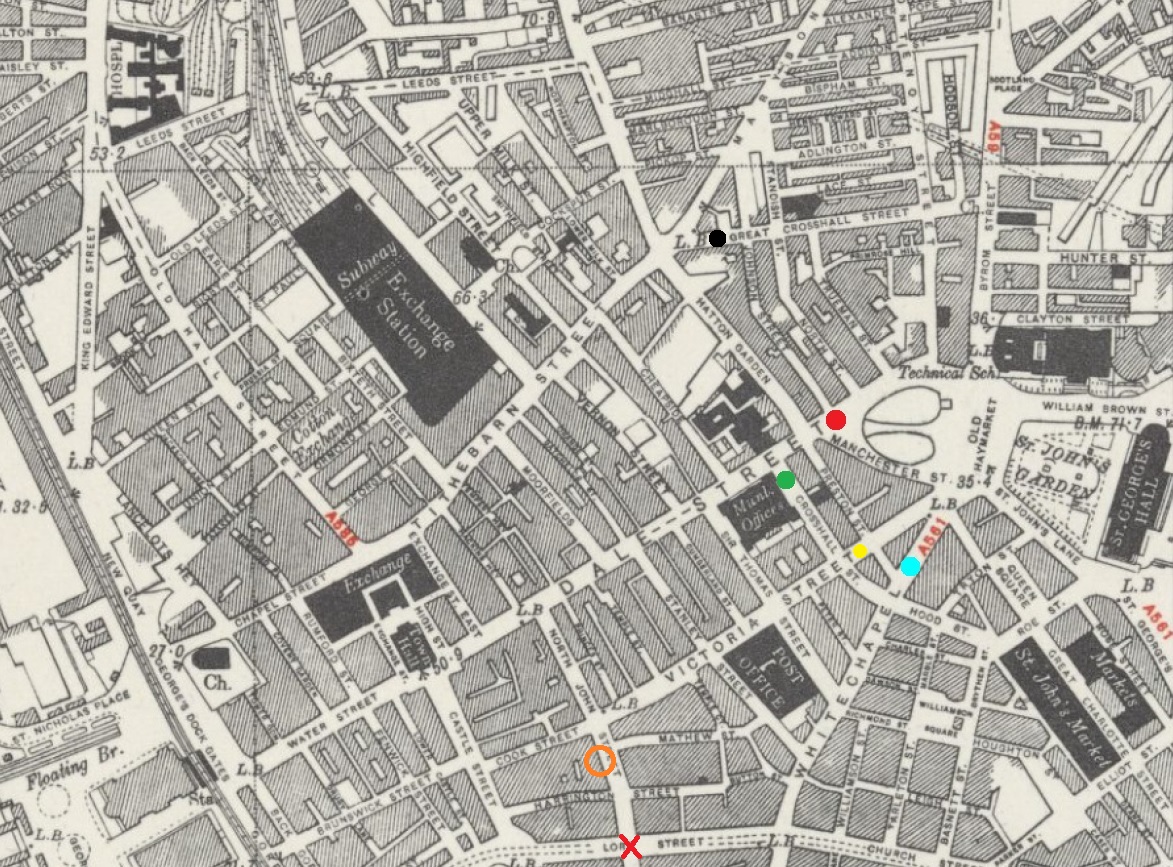
Black Circle: Gt. Crosshall Street; Red Circle: Dale Street; Green Circle: Crosshall Street; Blue Circle: Whitechapel; Yellow Circle: Victoria Street; Orange Circle: 24 North John Street (City Café/Chess Club). Red Cross: Tram stop William alighted at.
It is evident therefore that the shortest possible time from 29 Wolverton Street to the City Café was 23 and a half mins. and the longest to be expected assuming a car was just missed at Belmont Road would be 32 and a half mins, i.e. a 9 minutes wait. Mr.Wallace says it took him 30 minutes, 7.15 to 7.45.
I understand it is suggested by the Prosecution that instead of taking the direct line as above that Mr.Wallace went by way of a telephone box at the corner of Breck Road and Lower Breck Road, sent a call through to the Chess Club at the City Café, and then went down to the Club, presumably by car, direct from the telephone box.
This telephone box Tel.No.Anfield 1627 is one of the new concrete prepaid call type and is situated at the Northern corner of a traingular shaped small park marked on the map as Cabbage Hall. Lower Breck Road forks into two portions and joins Breck Road at two point with the small park between. One portion is marked as Rochester Road on the Ordnance Map but it, as well as the other fork, is labelled “Lower Breck Road”.
(7)
There is no direct route from WOlverton Street to this telephone box, and in any event to go there and then to the Belmont Road tram stop and so on to town necessitates going well out of the way.
After investigation I find that the shortest route for a pedestrian from the house to the box is as follows:-
From Wolverton Street through a narrow passage runing in a North Easterly direction to the top end of Redbourne Street, turn left to the top end of Redbrook Street, go through another narrow passage to the top end of Redcar Street, down Redcar Street to Lower Breck Road, cross over to and pass along the right hand fork to the telephone box. I agree with Mr.William henry Harrison that the distance from the house to the telephone box by this route is 400 yards.
The distance from the telephone box along Breck Road Anfield to the junction with Belmont Road is 523 yards.
Therefore the total distance from the house via the telephone box to Belmont Road is 923 yards as against 533 yards direct from the house to Belmont Road, an excess of 390 yards.
On April 8th. and 9th. last I tested the walking time from the house to the telephone box, and on the latter date went on from the box to North John Street with the following results:-
| Test C. (April 8th.) | Time taken |
| 29 Wolverton Street front dep. 3.37 | |
| Telephone box (An. 1627) arr. 3.41 | 4 mins. |
| Represents 3.41 miles per hour. |
(8)
| Test D. (April 9th.) | Time taken. | Time waiting. | |
| 29 Wolverton St. front dep. | 5.15.20 | ||
| Telephone box arr. | 5.19 | 3M. 40S. | |
| (- 4.1 miles per hour) | |||
| No.14 car to town dep. | 5.24.30 | 5M. 30S. | |
| Belmont Road arr. | 5.26.30 | 2M. 0S. | |
| do. do. dep. | 5.26.40 | 10S | |
| North John St. arr. | 5.43.30 | 16M. 50S. | |
| City Café arr. | 5.45 | 1M. 30S. | |
| 24M. 0S. | 5M. 40S. | ||
| Add actual waiting time | 5M. 40S. | ||
| Total | 29M. 40S. |
The minimum time to go from the house to the City Café via the telephone box may therefore be taken as 24 minutes, and as shown above on a service of 8/9 minutes the maximum time could be 33 minutes.
It will be observed that this is only half a minute longer than by walking direct to Belmont Road. This is accounted for by the fact that when going round by the telephone box the walking distance is decreased from 533 yards to 400 yards.
In both the above cases no time at all was allowed for using the telephone at the box. This should be added but apparently there is no evidence as to how long this might take, nor is there any evidence as to the length of time between the call when the City Café number was alleged to be engaged and the time the call was actually put through.
With regard to Mr. Wallace’s journey to and from Menlove Gardens West etc. on the night of January 20th.last I have made the following investigations and tests:-
(9)
I followed the following route:- From the back door of 29 Wolverton Street, South Easterly along the back passage, turn right South West, through a narrow passage into Richmond Park, cross Richmond Park diagonally to the narrow passage by the “New Institute” described above into Sedley Street, along one portion of Sedley Street still going South West to Pendennis Street, turn left (South East) along Pendennis Street, to Castlewood Road, turn right (South West) along Castlewood Road to Belmont Road and then turn left along Belmont Road (South East) to St.Margaret’s Church at the junction of Belmont Road and West Derby Road. (I note Mr.Wm.H.Harrison calls this “the corner of Belmont Road and Rocky Lane”).
I make the distance from the house to St.Margaret’s Church corner about 608 yards as compared with 605 yards as stated by Mr.Harrison.
There is a request stop for cars going South between Castlewood Road and St.Margaret’s Church and about 38 yards from Castlewood Road. I agree with Mr. Harrison that it is 375 yards from the house.
I wish to point out that if this is the tram stop at which Det.Sergeant Harry Bailey boarded the car going South on Jan.28th. his evidence is incorrect when he says he went “in Belmont Road to the right of Castlewood Road”. He repeats later that he followed the route shown in red etc. “except that when I got into Belmont Road I turned to the right to board the tram car at the ‘request stop’.” The next request stop to the right along Belmont Road is some considerable distance away, besides taking the witness away from his intended direction.
(10)
I have not checked the distance of 1.7 miles from St.Margaret’s Church to Smithdown Lane corner, (Harrison) as I consider it immaterial.
Test E.
On April 2nd. last I made a test from the house 29 Wolverton Street to Menlove Gardens West, and back from the Newsagent’s Shop 130 Allerton Road, with the following result:-
| p.m. | Time taken | Time waiting | |
| 29 Wolverton St. back dep. | 6.45 | ||
| Walked to St. Margaret’s Church arr. | 6.50.30 | 5M 30S | |
| do. do. dep. | 6.51 | 30S | |
| Smithdown Lane arr. | 7.1 | 10M 0S | |
| do. do. dep. | 7.2.30 | 1M 30S | |
| Penny Lane arr. | 7.11.15 | 8M 45S | |
| do. dep. | 7.12.45 | 1M 30S | |
| Menlove Gardens North arr. | 7.15.15 | 2M 30S | |
| Total walking and tram | 26M 45S | 3M 30S | |
| Waits | 3M 30S | ||
| Total to Menlove Gardens North | 30M 15S | ||
| Walked to Menlove Gardens West arr | 7.26 | 10M 45S | |
| Total | 41 mins. |
It will be noted that leaving the house at the same time as witnesses Prendergast and Forthergill on Jany.27th. and Bailey and Gold on Jany.26th. vis. 6.45, I apparently caught the same tram at St.Margaret’s Church but arrived at Smithdown Lane at 7.1 p.m. as against their 7.3 p.m. and 7.4 p.m. respectively.
(11)
In the dark I overran the stop at Menlove Gardens West and alighted at Menlove Gardens North.
I found it difficult to locate No.25 Menlove Gardens West as there was no number on the gate. No.27 had its number on in brass raised figures the same colour as the gate, and practically illegible.
There was apparently no number on 23 or 21, but No.19 was quite legible. See notes later on observations at a later date in daylight.
I did not attempt to find Green Lane but went direct to Allerton Road to the Newsagent’s shop, No.130.
Test F.
On April 9th. I made a further test in daylight with this result:-
| p.m. | Time taken. | Waits. | |
| 29 Wolverton St. back dep. | 3.34 | ||
| St.Margaret’s Church arr. | 3.40 | 6M 0S | |
| do. do. No.26 tram dep. | 3.44 | 4M 0S | |
| Smithdown Lane arr. | 3.55 | 11M 0S | |
| do. do. No.5 tram dep. | 4.0 | 5M 0S | |
| Penny Lane arr. | 4.10.40 | 10M 40S | |
| d. No.32 dep. | 4.11.40 | 1M 0S | |
| Menlove Gardens West arr.* | 4.13.40 | 2M 0S | |
| Tram and walking total | 29M 40S | 10M 0S | |
| Waits | 10M 0S | ||
| 39M 40S |
[Edited table to end here, as walk to MGW redundant considering Wallace did not go straight there. Included below anyway.]
| *Continuation of above from asterisk. | |||
| Walked to No.25 Menlove Gardens West arr. | 4.16.40 | 3M 0S | |
| Tram and walking total | 32M 40S | 10M 0S | |
| Waits | 10M 0S | ||
| 42M 40S |
I am informed by Mr.Priestley that on January 20th. last the only cars running from Belmont Road to Smithdown
(12)
Lane and where the No.26 route which run via Sheil Road, Kensington, Holt Road, Durning ROad and Tunnel Road, and that up to 7.2 p.m. it was a 4 minute service, after that to 9.2 p.m. it was a 4 minute service, after that to 9.2 p.m. it was a 4 to 5 minute service. In the reverse direction it is the No.27 route at the same times.
From Smithdown Lane to Penny Lane along Smithdown Road there are six route numbers, the services vary from 5 and 6 minutes to 40 minutes, and one (the 5a) is at irregular intervals but passing the junction at fixed times. It is obvious that with the complication of times it is not possible to say definitely what is the maximum normal time of a wait at this junction, but with the exception of a hold up in the traffic or a breakdown on the cars, I should say 5 minutes would be the maximum. (I had to wait 5 minutes in test F. and then several cars arrived close to each other.)
From Penny Lane to Menlove Gardens there are five route numbers and the same remarks apply as to complications of service intervals. I should say four minutes as a maximum wait would be about right.
It appears therefore that the minimum time possible from 29 Wolverton Street to Menlove Gardens West is 26 minutes, (Test E.) and the maximum 42 minutes. [Inaccurate, using walk to 25 Menlove Gardens West?]
| Test F. | ||
| M.S. | ||
| 29.40 | tram and walking time | |
| 4.0 | possible wait at St.Margaret’s Church. | |
| 5.0 | possible wait at Smithdown Lane. | |
| 4.0 | possible wait at Penny Lane | |
| 42.40 | say 42 minutes. |
To this must then be added time for walking up Menlove Gardens West to No.25 [why?] (which took me 3 minutes)
(13)
and in finding the house, which as explained above I found difficult in the dark on April 2nd.
On this occasion in daylight I examined the numbers further and find as follows:-
No.15 is legible and also name “Braemar”
No.17 is not legible in the dark.
No.19 is legible.
No.21 has no number on but has name “Barholme”.
No.23 has no number but has name “Halliwell”.
No.25 has no number but has name “Brierley”.
No.27 has raised figures difficult to see in the dark, and also has name “Dalkeith”.
There is a street lamp on the opposite side of the road opposite No.21. There is a street lamp on same side of road at the party fence between Nos.15 and 17.
Test G. Return journey, April 2nd.
I called at No.130 Allerton Road about 7.34 and bought a Liverpool Echo. There were two women in the shop serving one middle-aged, with light hair, a roundish face and pleasant manner, who served me, the other I did not observe particularly but she was younger.
I then returned to Wolverton Street as follows:-
| Time taken | Waits | ||
| M. S. | M. S. | ||
| 130 Allerton Road dep. | 7.35 | ||
| Walked to Queens Drive arr. | 7.36.30 | 1 30 | |
| No.8 car Queens Drive dep. | 7.38 | 1 30 | |
| ** Smithdown Lane arr. | 7.52.30 | 14. 30 | |
| No.27 Smithdown Lane dep. | 7.53 | 0 30 | |
| St.Margaret’s Church arr. | 8.3.30 | 9 30 | |
| 29 Wolverton St.front arr. | 8.10.30 | 7 0 | |
| Tram and walking total | 32 30 | 2 0 | |
| Waits | 2 0 | ||
| Total | 34 30 |
(** Including the longer stop at Penny Lane)
(14)
Test E. Return Journey, April 9th.
| Time taken | Waits | ||
| M. S. | M. S. | ||
| 25 Menlove Gardens West dep. | 4.23 | ||
| Walked to Green Lane (top) arr. | 4.26 | 3 0 | |
| Walked down Green Lane to Allerton Road arr. | 4.30 | 4 0 | |
| Junction Green Lane-Allerton Road dep. | 4.31 | 1 0 | |
| 130 Allerton Rd. arr. | 4.34.30 | 3 30 | |
| Total | 10 30 |
To this should be added time for talking to P.C.Jas.Ed.Serjeant and for finding the way to the Newsagent’s if a stranger.
P.C.Serjeant is not quite correct when he says the Allerton Police Station “was just across the way”. That is to say, it is not across the street in the ordinary sense, it is to the left across a triangular green and I should think at least 200 yards away.
I again called in the Newsagent’s shop 130 Allerton Road and bought a box of Swan Matches. On this occasion there was only one person serving in the shop, a dark girl with glasses, wearing a maroon jumper, white overall coat and pearl necklace. Unfortunately the other lady who, I presume was the manageress, was not in. I mention these points as if neither of these women recognised me after calling twice it might throw some doubt on their identification of Mr.Wallace if he only called once. Against this, of course, if he did actually ask for a directory, it would pick him out from the ordinary run of customers and if he admits himself that he called, there is of course nothing in the point.
(15)
I then returned to Wolverton St. as follows:-
| Test H.(contd.) | Time taken | Waits | |
| M. S. | M. S. | ||
| 130 Allerton Road (just missed a No.8 which run on an 8 minute service) dep. | 4.36.20 | ||
| Walked to Queens Drive stop arr. | 4.38 | ||
| Walked to Queensdale Rd.stop arr. | 4.42 | ||
| Walked to Penny Lane arr. | 4.44 | 7 40 | |
| No.7 car Penny Lane dep. | 4.58 | 3.30 | |
| St.Margaret’s Church arr. | 5.8 | 10 0 | |
| St.Margaret’s Church dep. | 5.8.20 | 30 | |
| 29 Wolverton St. front arr. | 5.14.40 | 6 20 | |
| Tram and walking total | 33 30 | 4 50 | |
| Waits | 4 50 | ||
| Total | 38 20 |
The same remarks as to longest possible wait at Smithdown Lane applies, there is no wait necessary at St.Margaret’s Church, so that it would appear that the maximum time from 130 Allerton Road to 29 Wolverton Street is 33 mins. 30 secs. as above
add 5 mins. 0 secs. possible wait at Smithdown Lane
Total 38 mins. 30 secs.
Finally with reference to Mr.Wallace’s journey to the City Café on January 19th, walking to Belmont Road and Breck Road junction taking tram to North John Street and walking to the City Café, the time he states as 30 minutesis reasonable and consistent.
It is also possible to go round by the telephone box
(16)
at Cabbage Hall and provided one takes a tram direct from there, and there is one available immediately, it is possible to arrive at the City Café in about the same time, but this does not allow any time for making a telephone call, much less for waiting for the line to be cleared after the number was engaged.
With reference to the journey to Menlove Gardens West etc. on January 20th.
It appears that the test times taken by the Police on various dates so far as they go i.e. to Smithdown Lane only, are reasonable.
I wish however to point out the following discrepancies.
I do not know when Mr.Wallace is supposed to have left his house on this occasion, but tram conductor Phillips says he left Smithdown Lane at 7.6 or 7.10, it would not be earlier but might be later. He sent Mr.Wallace to a No.7 car at Penny Lane and saw him go towards it. Tram conductor Thompson says Mr.Wallace got on his No.5a (not No.7) car at Penny Lane at 7.15.
If Phillips did not leave Smithdown lane till 7.10 this is manifestly impossible as it only allows 5 minutes for the journey to Penny Lane.
My times are as follows:-
Test E. 8 mins. 45 secs.
Test F. 10 mins. 40 secs.
Test H. 9 mins. 30 secs.
Average 9 mins. 38 secs.
Sydney Hubert Green states that he lives at 16 Towers Road, Wavertree. This road is off Woolton Road and I should think is about 5 minutes walk from 25 Menlove Gardens West. He states he left his house at 7.10 and proceeded down Menlove Gardens West when he was accosted by Mr.Wallace.
This would be about 7.15 and therefore still only 5 minutes after Mr.Wallace left Smithdown Lane according to Phillips’ departure time of 7.10.
(17)
Taking Phillips’ 7.10 as correct Mr.Wallace could not have got to Menlove Gardens West earlier than 7.24 made up as follows:-
Smithdown Lane 7.10 p.m.
To Penny Lane 9 mins. 38 secs. (Average E.F.H.)
To 25 Menlove Gardens West 5 mins. 0 secs. (Test H.)
Total: 7.24.38 p.m.
From 7.24 to 7.45 when it is alleged Mr.Wallace left P.C.Serjeant at the corner of Allerton Road and Green Lane does not give very much time for the search for No.25 Menlove Gardens West [Note: He went there previous to this, so this appears redundant?], the interview with Mrs.Mather, the walk to and down Green Lane (which took me 7 minutes) and the conversation with the constable.
On the other hand from 7.45 when it is alleged Mr. Wallace left the constable at the corner of Green Lane and Allerton Road until “a good while after 8” as stated by Lily Pinches as the time of his arrival at 130 Allerton Rd. may mean anything, but is certainly excessive.
I have no evidence before me as to what time Mr.Wallace is alleged to have spoken to his neighbours (The Johnsons?) [Johnstons, and it’s 8.45 p.m.]. However the witness Lily Hall states that she saw Mr.Wallace in Richmond Park by the Parish Hall at 8.35, and as the journey from 130 Allerton Road to Wolverton St. takes about 38 minutes it is obvious that either Lily Pinches or Lily Hall is incorrect.
In the above tests I have been working to the nearest 10 seconds interval; in some of my more detailed notes which I have in hand, on fine points I have worked to the nearest 5 seconds.
(Signed) Maddock
30, Lord Street. Liverpool.
16th. April, 1931.
—
My Summaries
(May have made some mistakes. Recommend using the official transcribed document.)
Tests to the Central Chess Club using Wallace’s claimed route:
Test A:
Timed the route from Wallace’s back door to the door of the Central Chess Club via Belmont Road, the route Wallace claims to have used.
24 minutes with no wait time, 33 minutes with a 9 minute wait.
Maddock waited 4 minutes making a journey time of 28 minutes.
= 19:43 arrival time from 19:15.
Range of journey time: 24 to 33 minutes.
Range of arrival: 19:39 to 19:48.
…
Test B:
Timed the route from the Belmont Road tram to the door of the Central Chess Club.
18 minutes and 20 seconds.
…
Summary of Tests: Shortest possible time 23 minutes and 30 seconds, to 32 minutes and 30 seconds from the back door of Wallace’s home. 18 minutes 20 seconds, to 27 minutes 20 seconds from the tram by the phone box.
Range of arrival: 19:38.30 to 19:47.30.
—
Tests to the Central Chess Club using the phone box route:
Test C:
Timed the route from Wallace’s front door to the phone box.
4 minutes (3.41 mph walking speed). In test D Maddock accomplished this in 3 minutes 40 seconds at 4.1 mph.
…
Test D:
Timed the route from Wallace’s front door to the door of the Central Chess Club using the tram by the telephone box the Qualtrough call was made from.
24 minutes with no wait time (4.1 mph walking speed to the call box), 33 minutes with a 9 minute wait.
Maddock waited 5 minutes 40 seconds making a journey time of 29 minutes 40 seconds.
= 19:44.40 arrival time from 19:15.
Range of journey time: 24 to 33 minutes.
Range of arrival: 19:39 to 19:48.
Excludes the time that would be required to stop and make the telephone call. Based on operator testimony the call came in around 19:15 and was patched through at 19:20. The call duration with the City Cafe is unknown.
The Qualtrough call dialogue: https://www.williamherbertwallace.com/case-files/qualtrough-call-dialogue/
It may be fair to assume a 4 or 5 minute conversation with the City Cafe (Gladys claims to have waited about a minute after the successful connection), and by testimony ~5 minutes when including time spent talking to the operators, but the precise pick-up time is unknown.
If Wallace had made the call as per the prosecution, the call was put through at 19:20 and may have ended around 19:24 or later based on the dialogue. With a minimum journey time of 20 minutes and 30 seconds from the nearby tram stop should he have left the box, walked to the stop, and instantly boarded, he should arrive at the club between about 19:44 to 19:53 depending on the tram wait time. By Beattie’s statement it does not seem as though the voice was anxious to end the call to – say – jump on a tram he sees arriving in order to cut out the wait time.
An arrival time at the club of 19:45 or before is much more consistent with him having not made the call, but either route is equally possible foregoing the telephone call.
Summary:
If William placed the telephone call or was with the person who did, hanging up at 18:24 he should get to the club at between around 18:44.30 and 18:53.30. If he went by his claimed route at his claimed time of leaving home, he should get there between 19:39 and 19:48.
If a person saw William and went to the phone box, it would take about 1 to 2 minutes to walk from the T-junction between Richmond Park and Breck Road to the call box, and 3 minutes to walk from Wallace’s house to the T-junction (though he could be sighted at any point along Richmond Park, and the “stalker” could be in a different location or with a car).
If the call came in at 19:15, we might need to add on about 2 to 4 minutes to be fair… Meaning William would have probably left more along the lines of 19:11 to 19:13 and should have gotten to the club at 19:35 to 19:46.
If he made the call or stayed with someone else as they did, he still would be boarding the tram near the box at roughly hangup time, and therefore get to the club from there at 19:44 to 19:53 approximately.
The diversion of one of the tram cars on the route that night might have added an unknown amount of time onto this, and William also claims to have stopped to post a letter on his way to the tram.
The second operator also initially claimed to have picked up the phone at 19:15 (before changing to 19:17), which was a minute or two after the first operator. If the operators are off in their timing this would also skew the timings.
(By inference from the below files, by excluding the walking time to the phone box we can take the journey time from the tram near the phone booth to the door of the chess club to be 20 minutes and 30 seconds).
—
Tests between Menlove Gardens West and 29 Wolverton Street:
Further tests were of Wallace’s journey to and from Menlove Gardens took place. One terminated at Menlove Gardens North but can be dismissed as the conductor put him off at Menlove Gardens West. Maddock also walked to 25 Menlove Gardens West upon arrival.
The maximum wait time for the journey to the Gardens was said to be 4 minutes. On the return, the maximum wait time at Smithdown Lane is said to be 5 minutes and 4 minutes at Penny Lane, with no wait time necessary at St. Margaret’s Church (as Wallace walked home from here), giving a maximum wait time of 9 minutes total.
The time using Wallace’s route (minus the 3 minute walk to 25 Menlove Gardens West as he did not immediately go there) was ascertained to be 29 minutes 40 seconds with no waiting times; Maddock waited 10 minutes in total, giving a journey time of 39 minutes 40 seconds.
The return journey was ascertained as 33 minutes and 30 seconds without any waiting times; Maddock waited 4 minutes 50 seconds in total, giving a journey time of 38 minutes and 20 seconds.
From Wallace’s stated departure times of 18:45 from his back door, and 20:00 returning home to his front door, the following times can be ascertained:
Minimum Journey from 29 Wolverton Street to Menlove Gardens West:
29 minutes and 40 seconds.
According to Maddock’s tests (refer to Test F, minus the 3 minute walk to 25 Menlove Gardens West and all wait times), Wallace could not have left his back door later than 18:49 to get to Smithdown Lane at 7:06 with no wait time on either the first tram or the one at Smithdown Lane. The maximum wait time for the tram is 4 minutes at the first stop and 5 minutes at Smithdown Lane, meaning an average total wait time of 4 and a half minutes (2 minutes at the first stop, 2 and a half at the second).
An average wait time at both stops makes Wallace’s 18:45 departure time more plausible.
Of note, Lily Pinches believes Wallace to have been in her shop some time after 8 PM. Given the data, this means either Lily Pinches or Lily Hall has apparently made a mistake in their testimony.
—

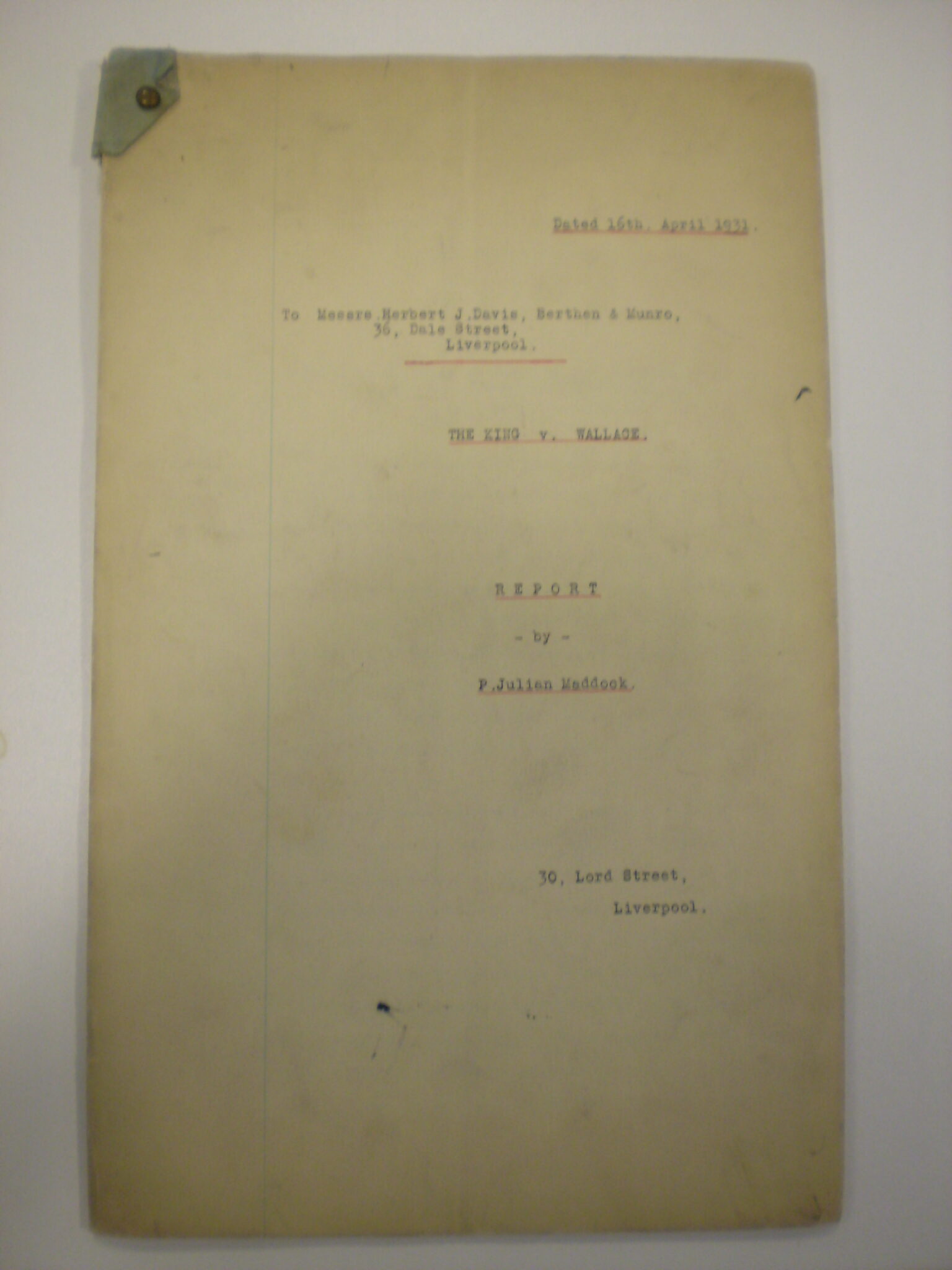
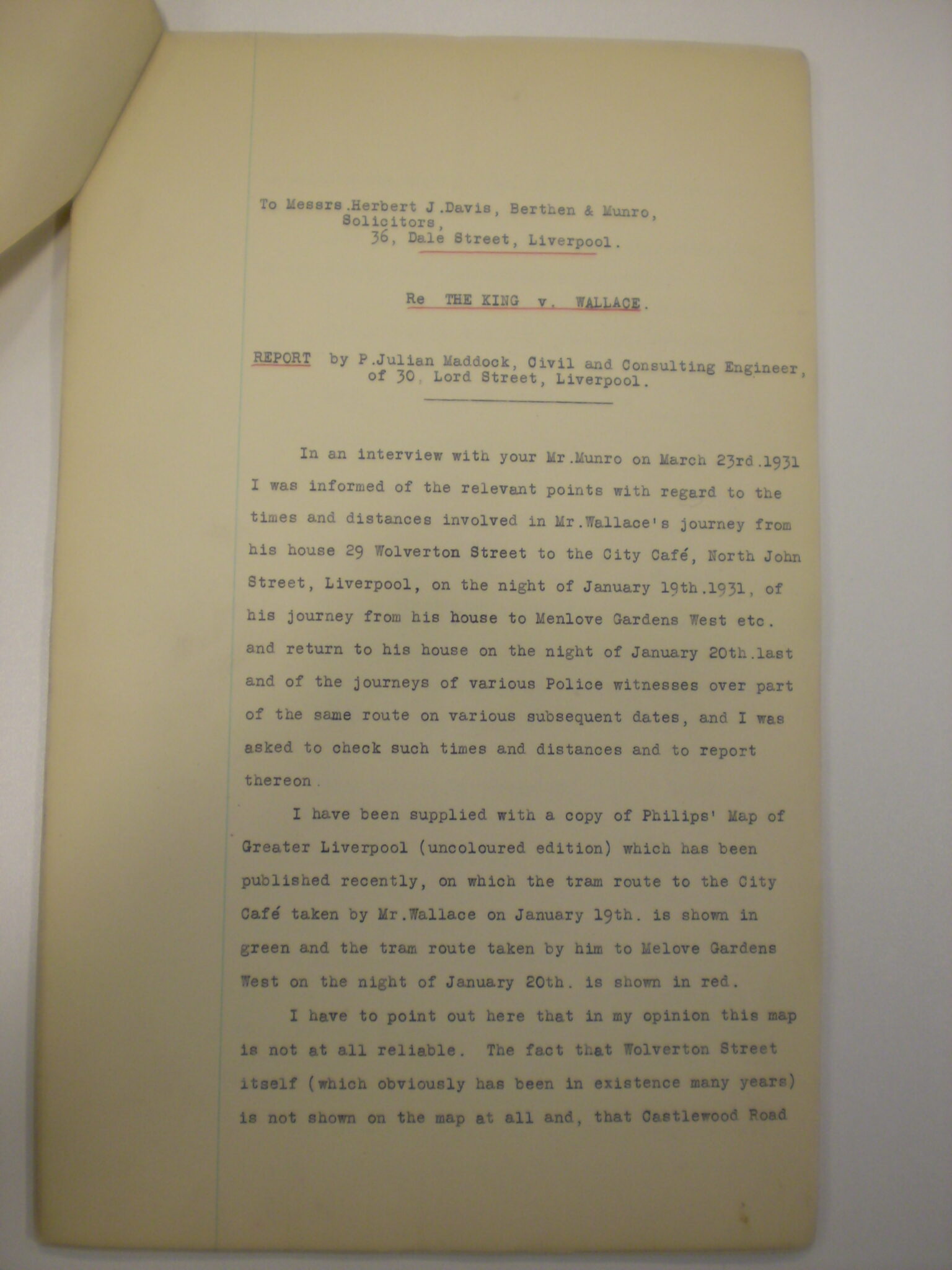
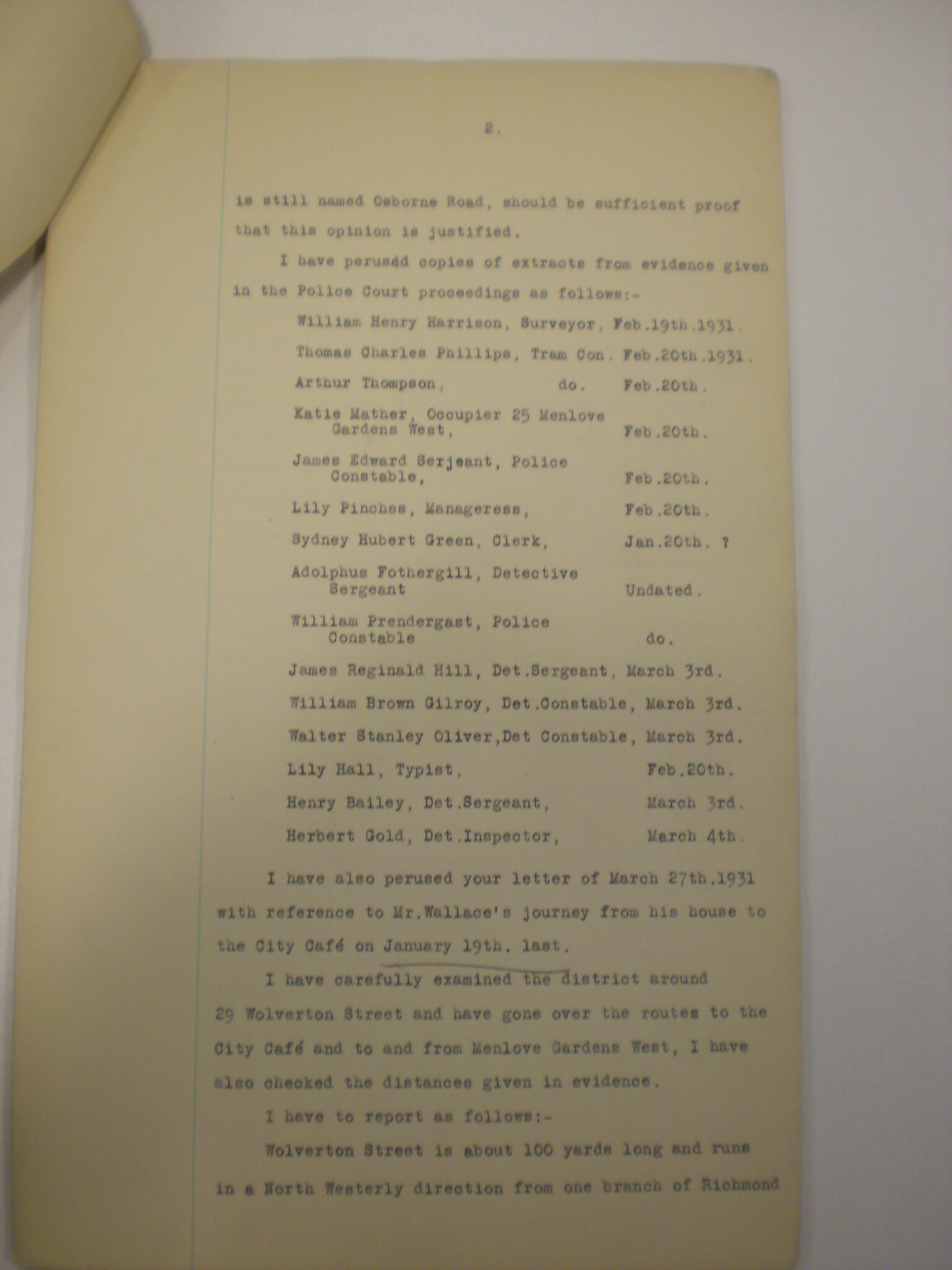
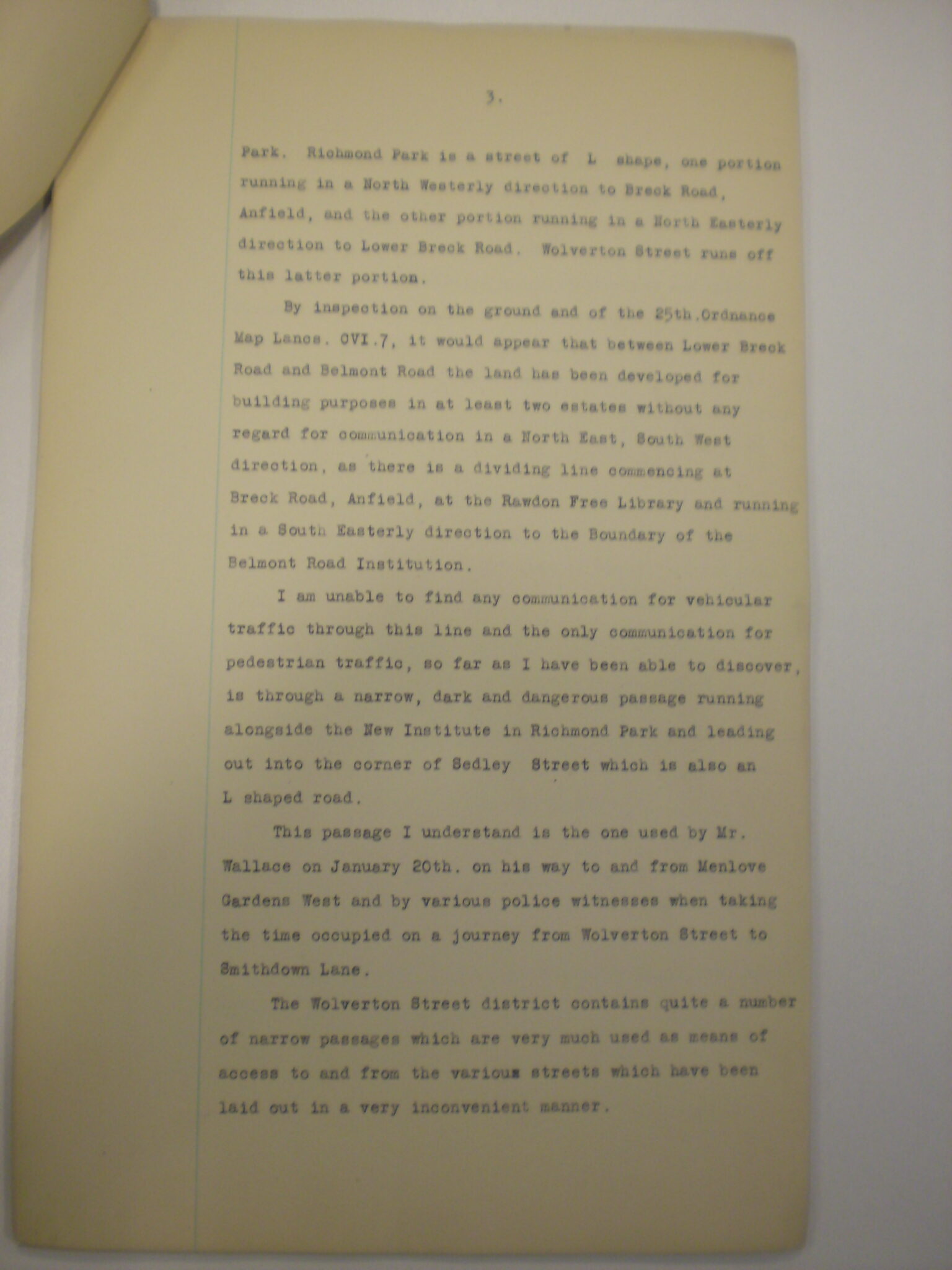
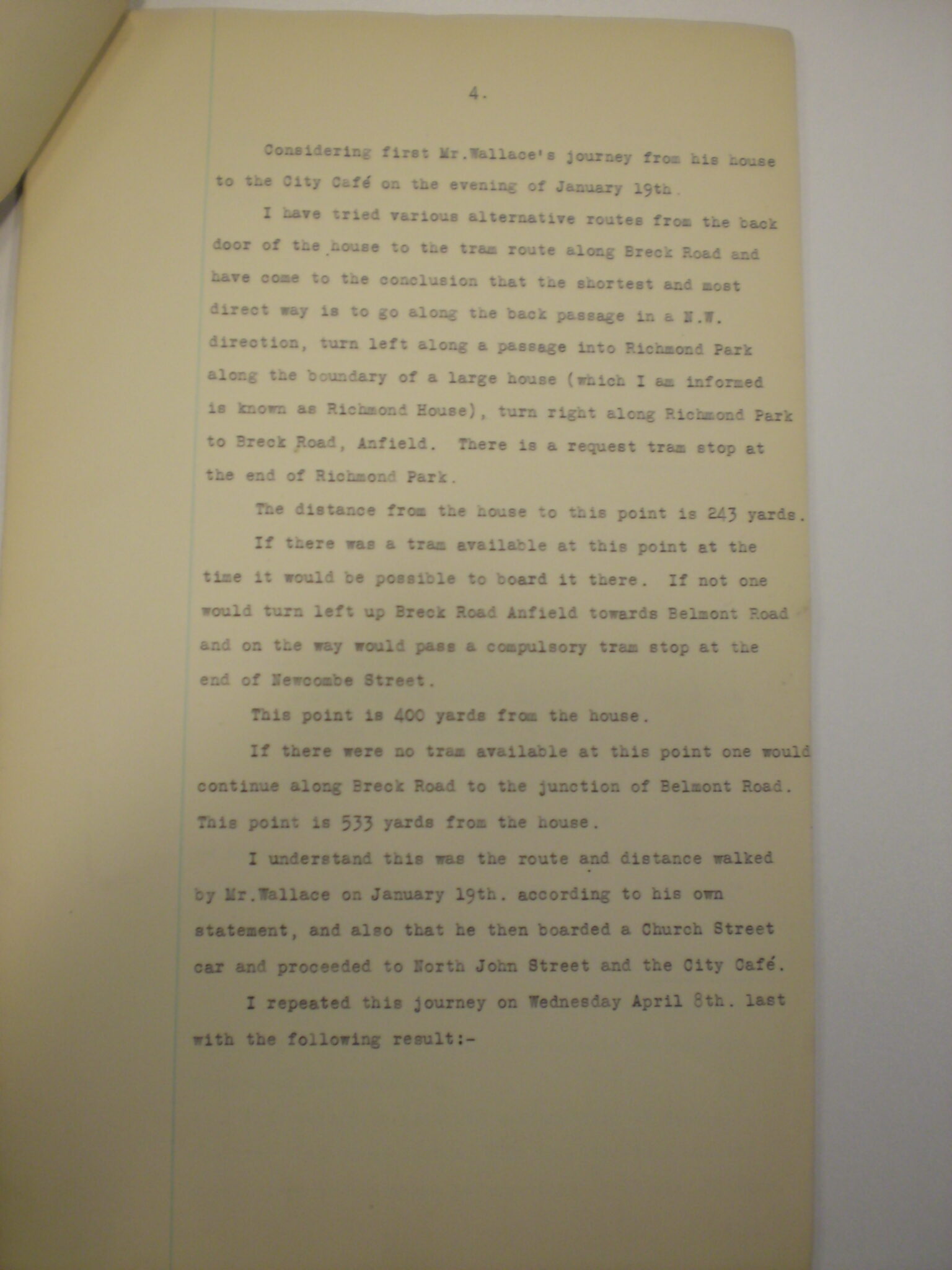
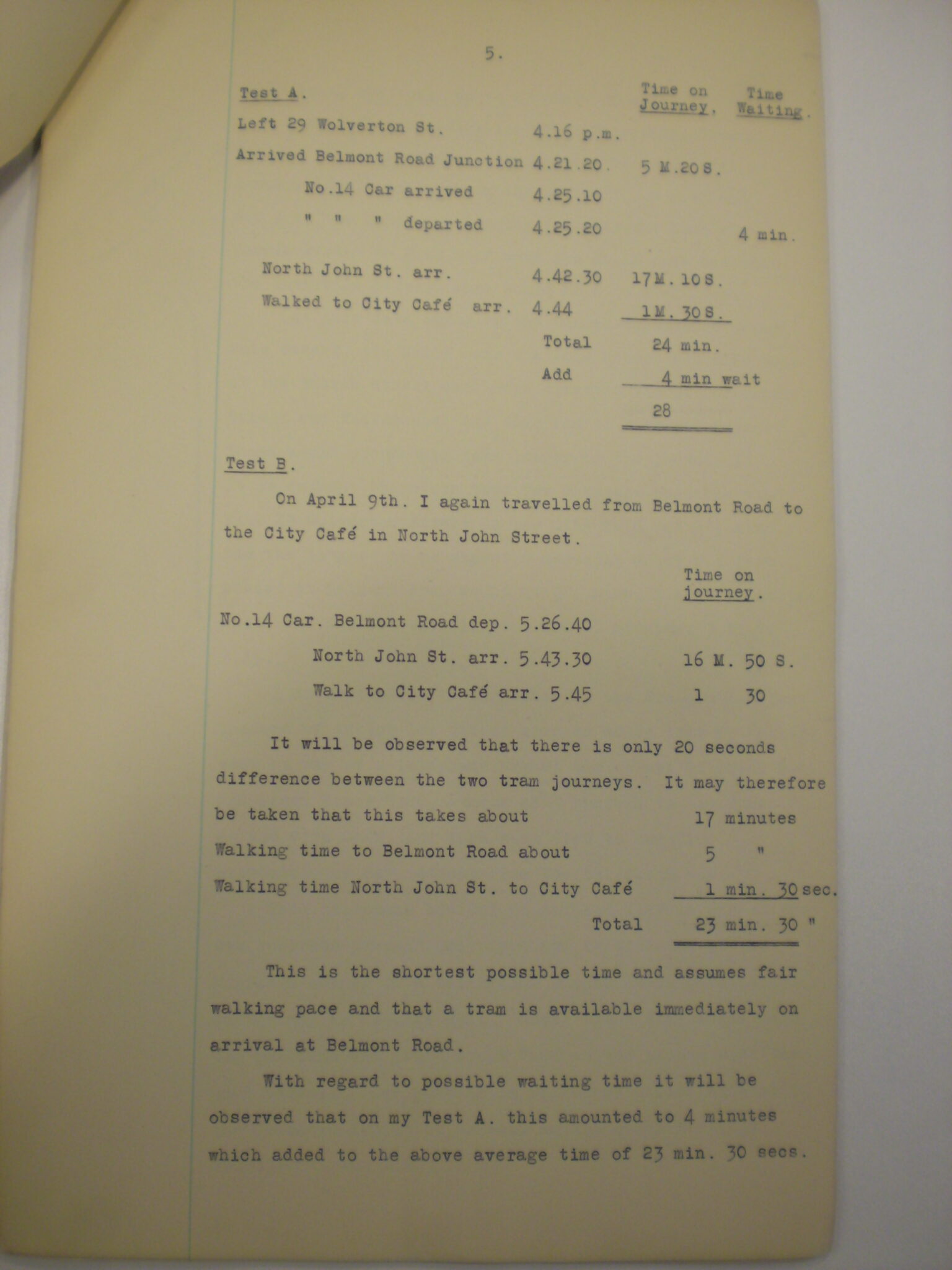
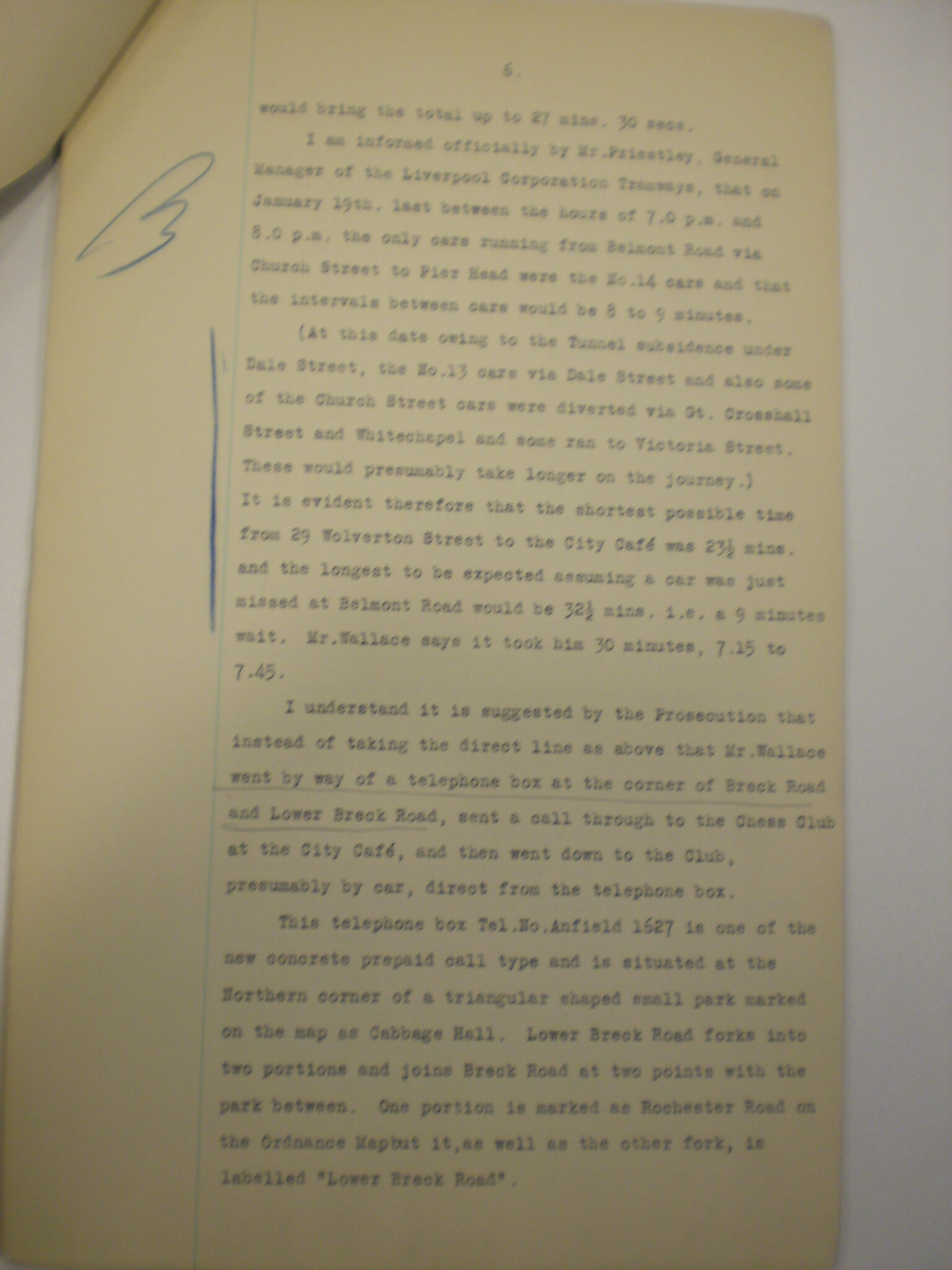
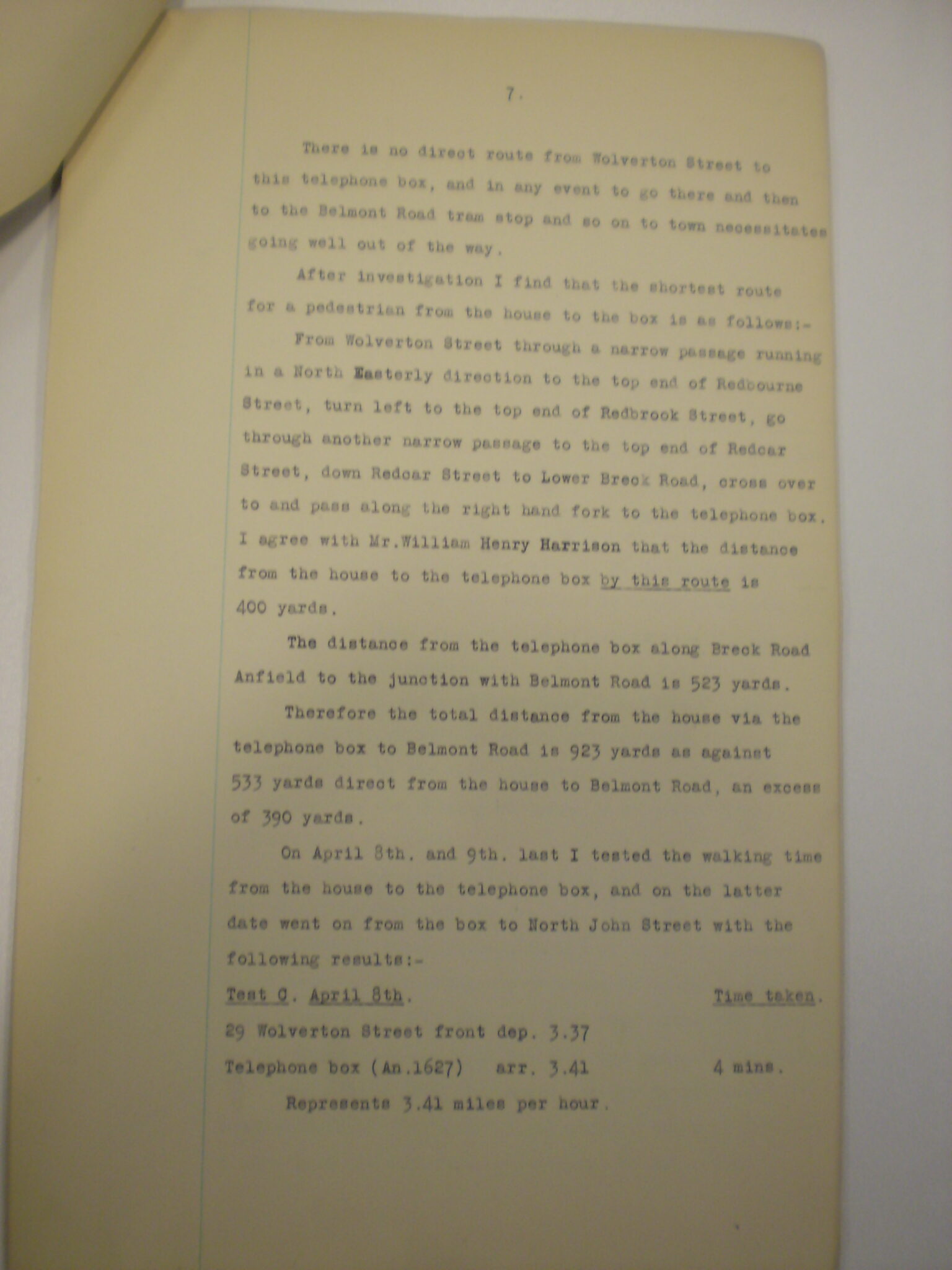
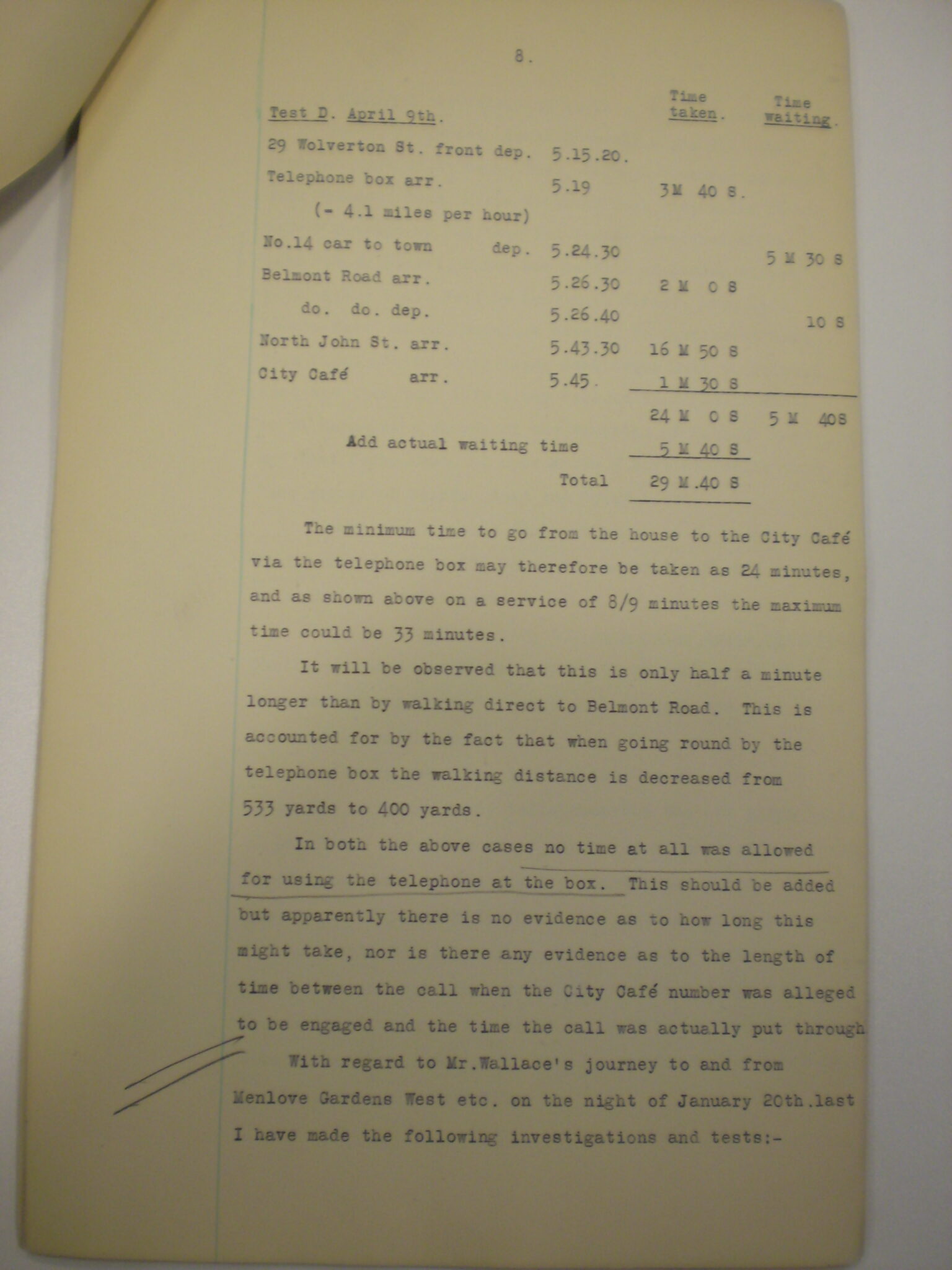
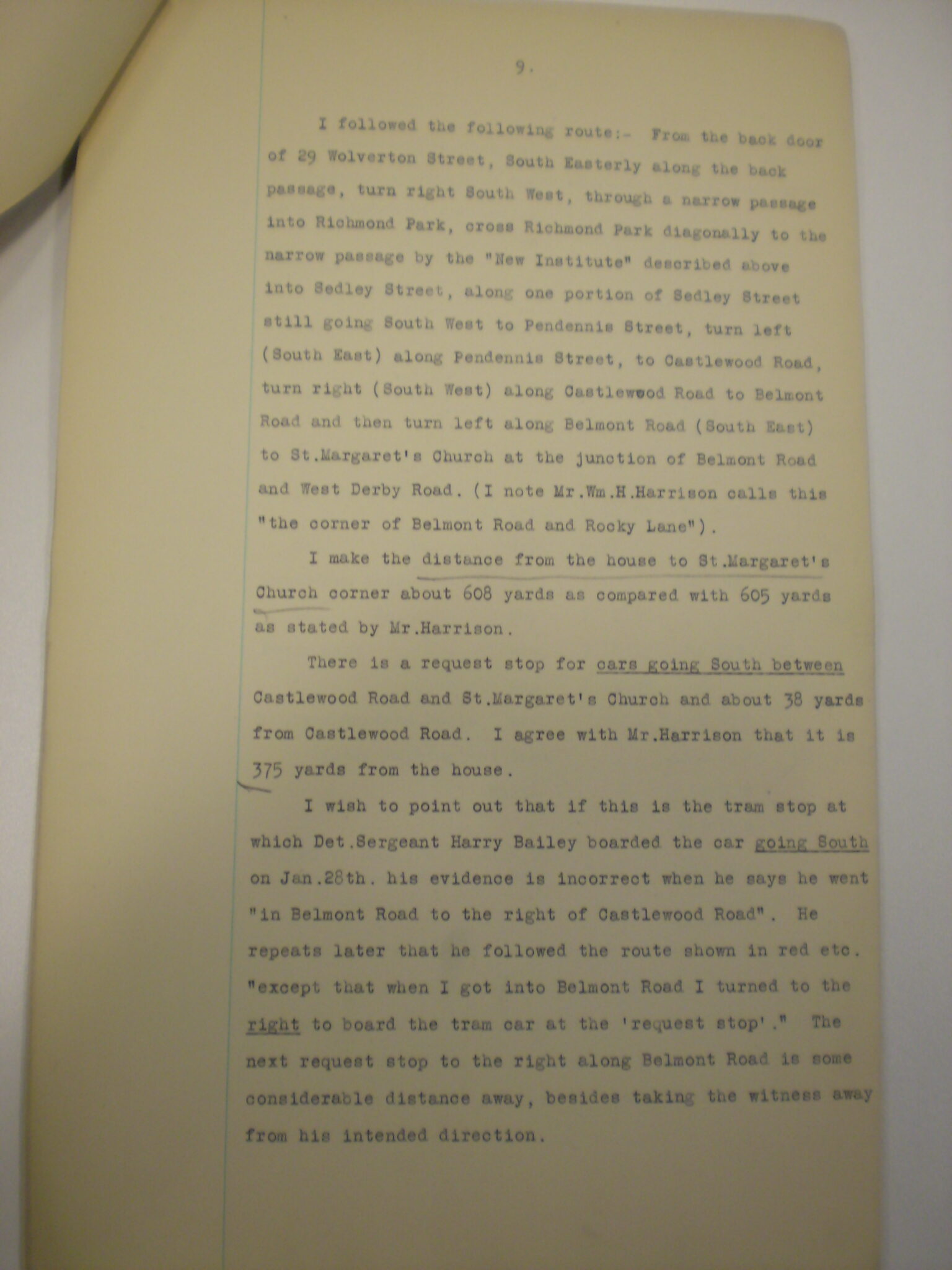
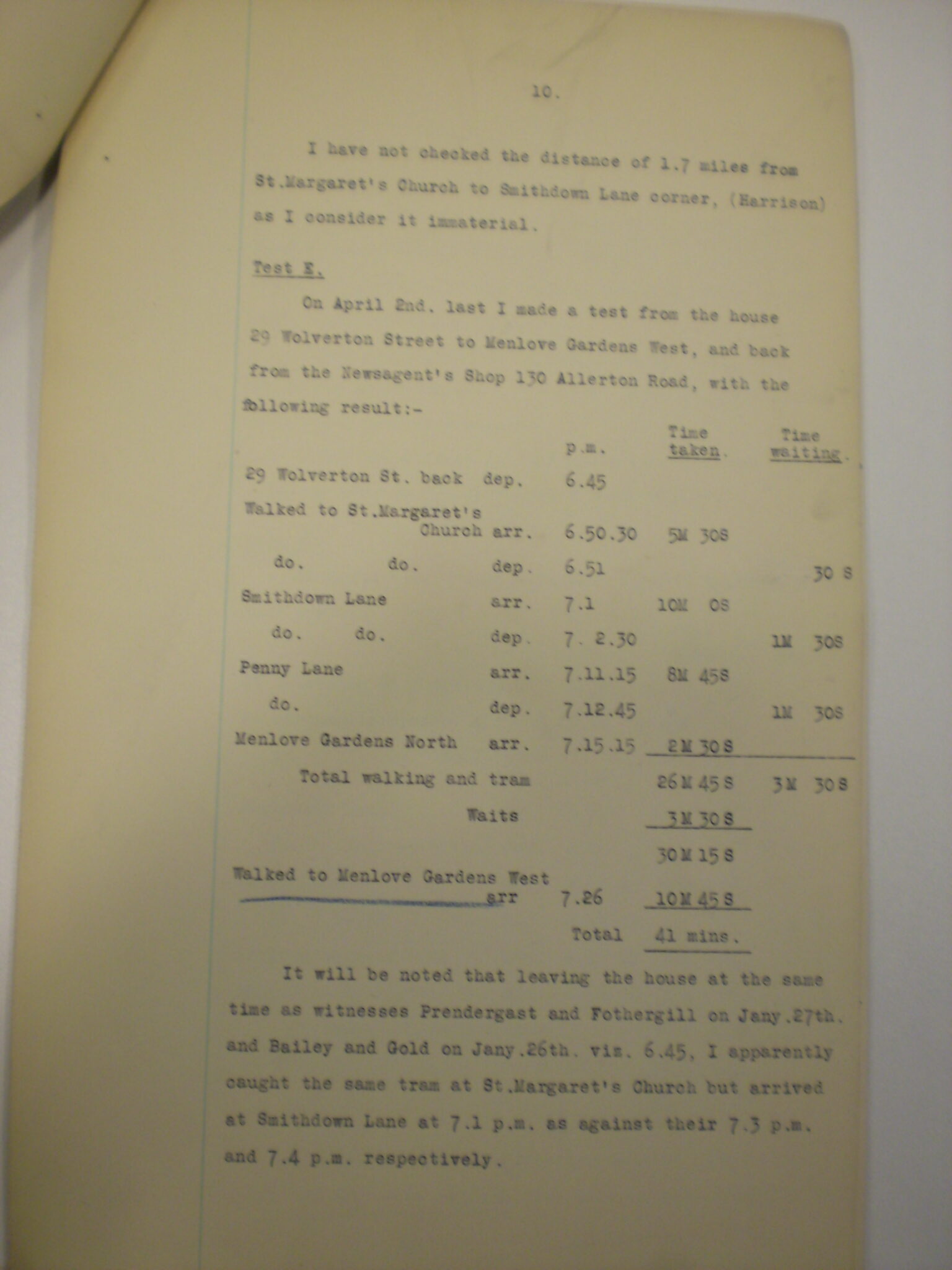
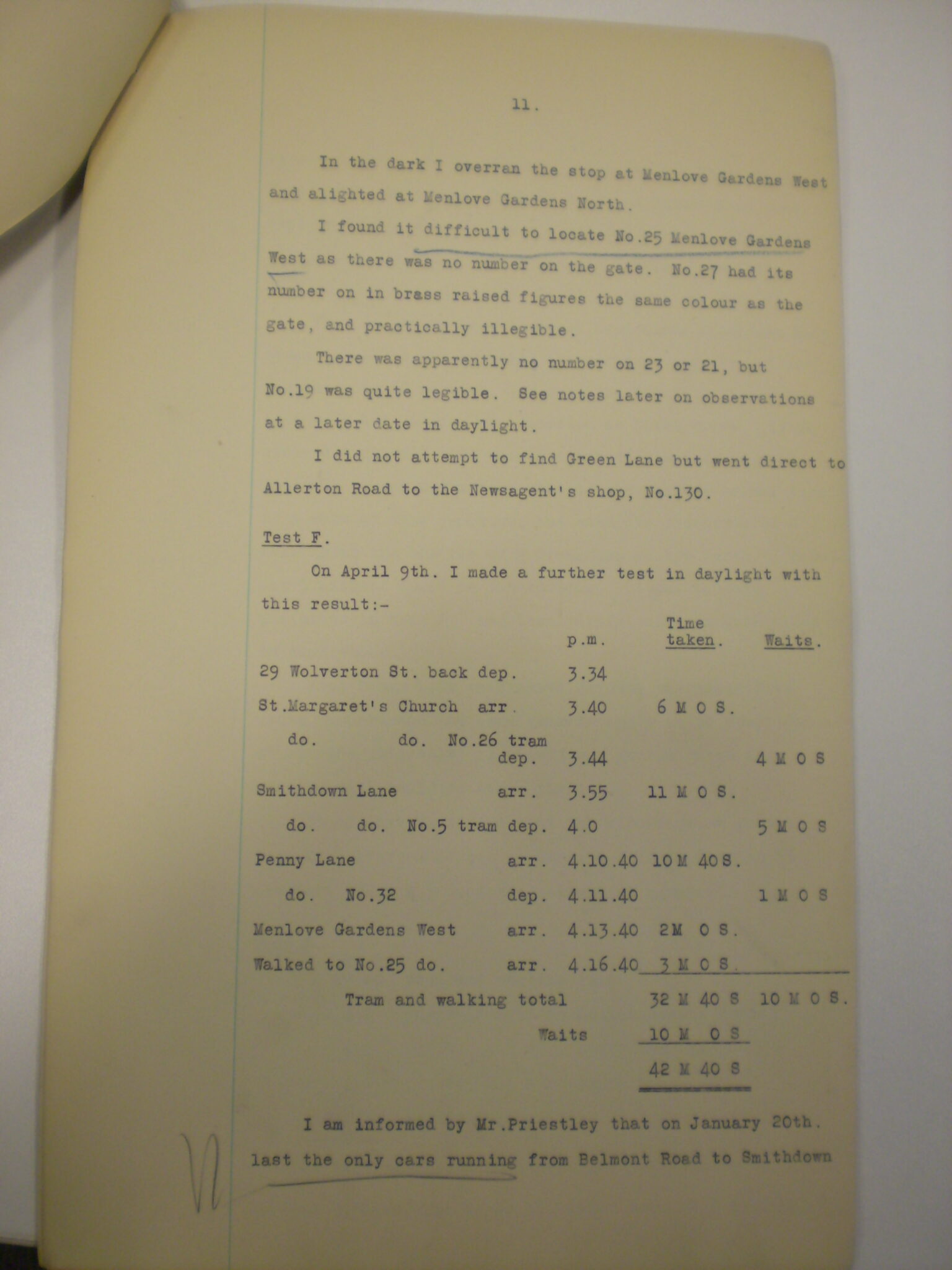
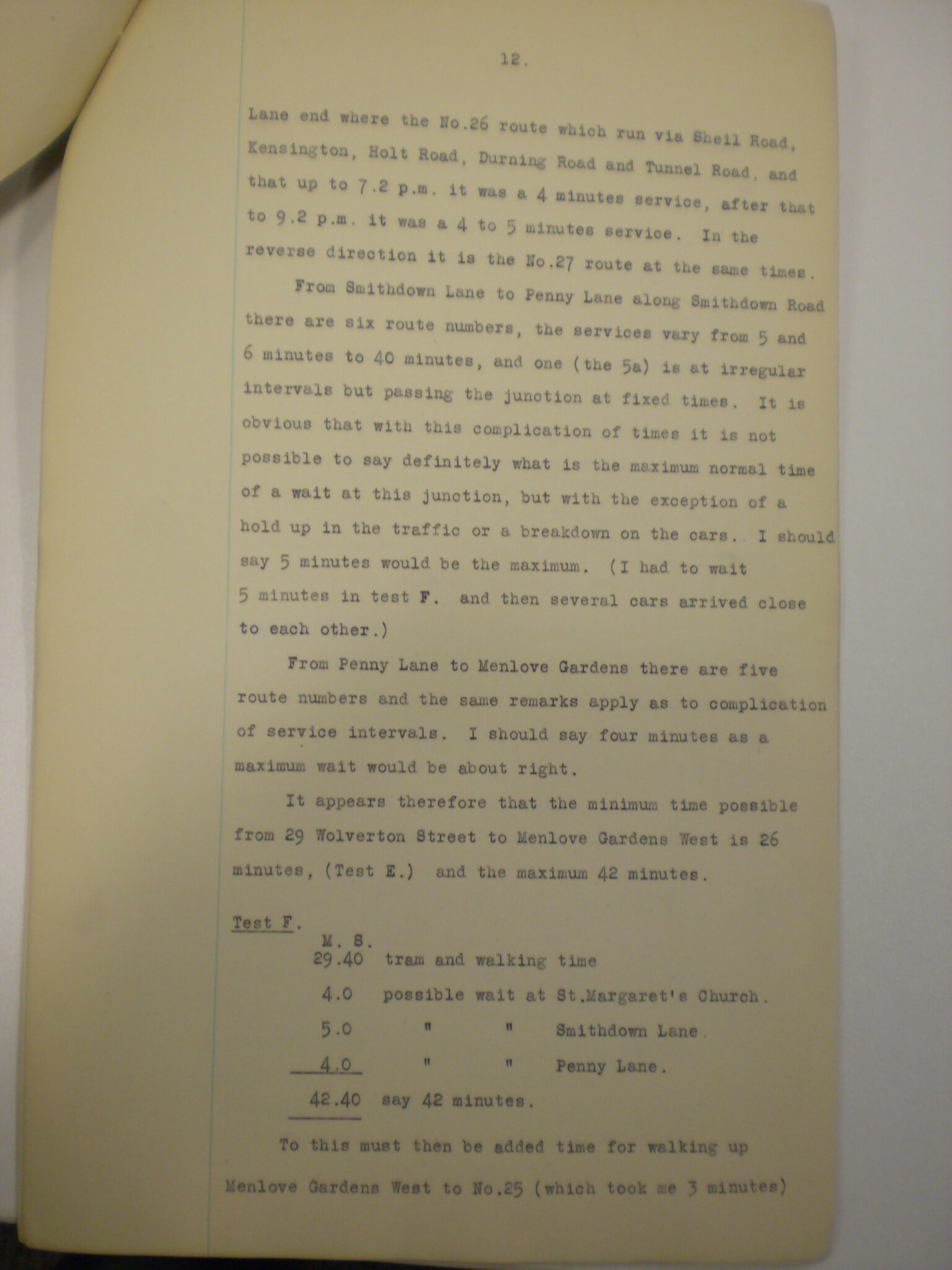
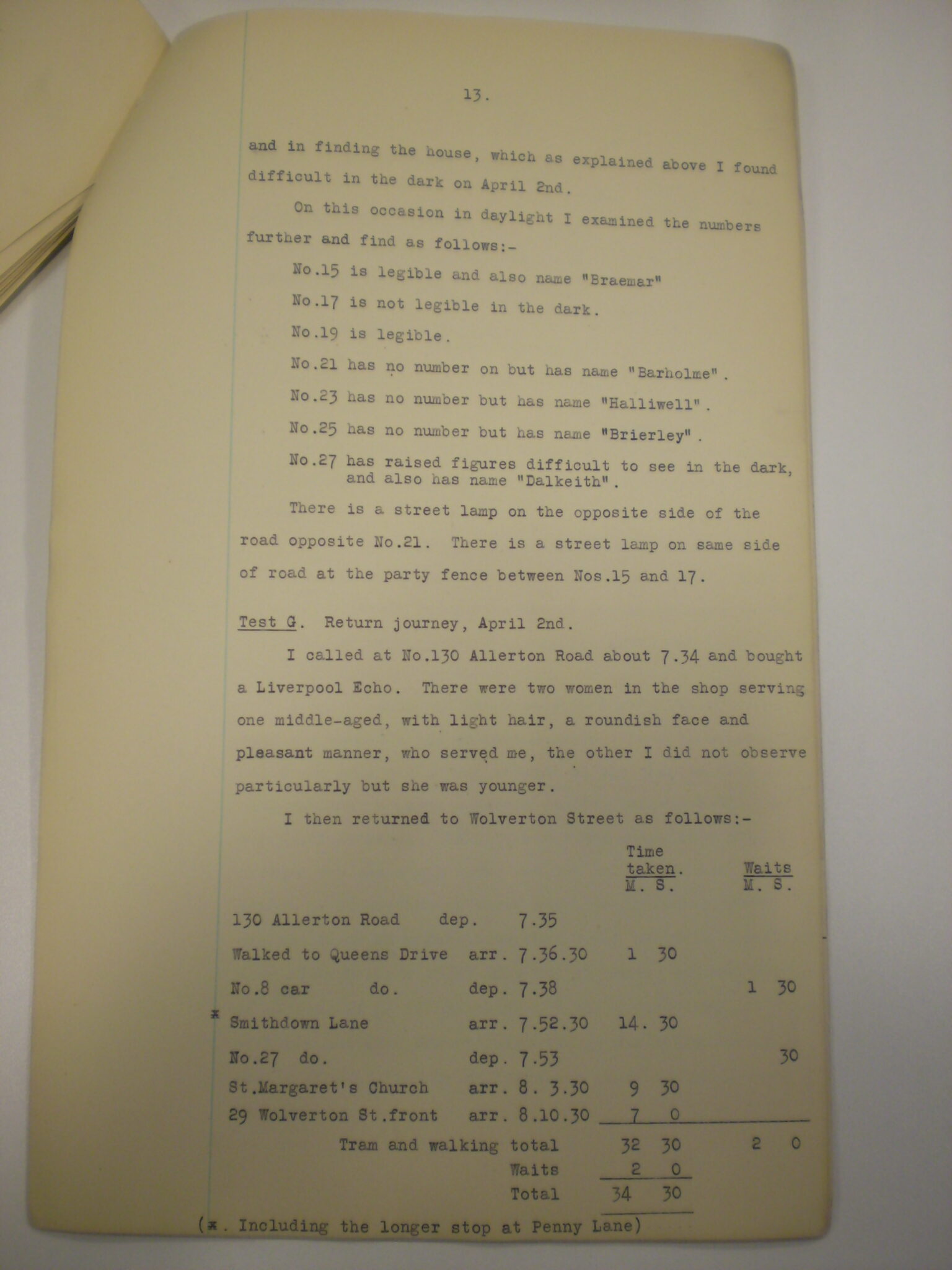
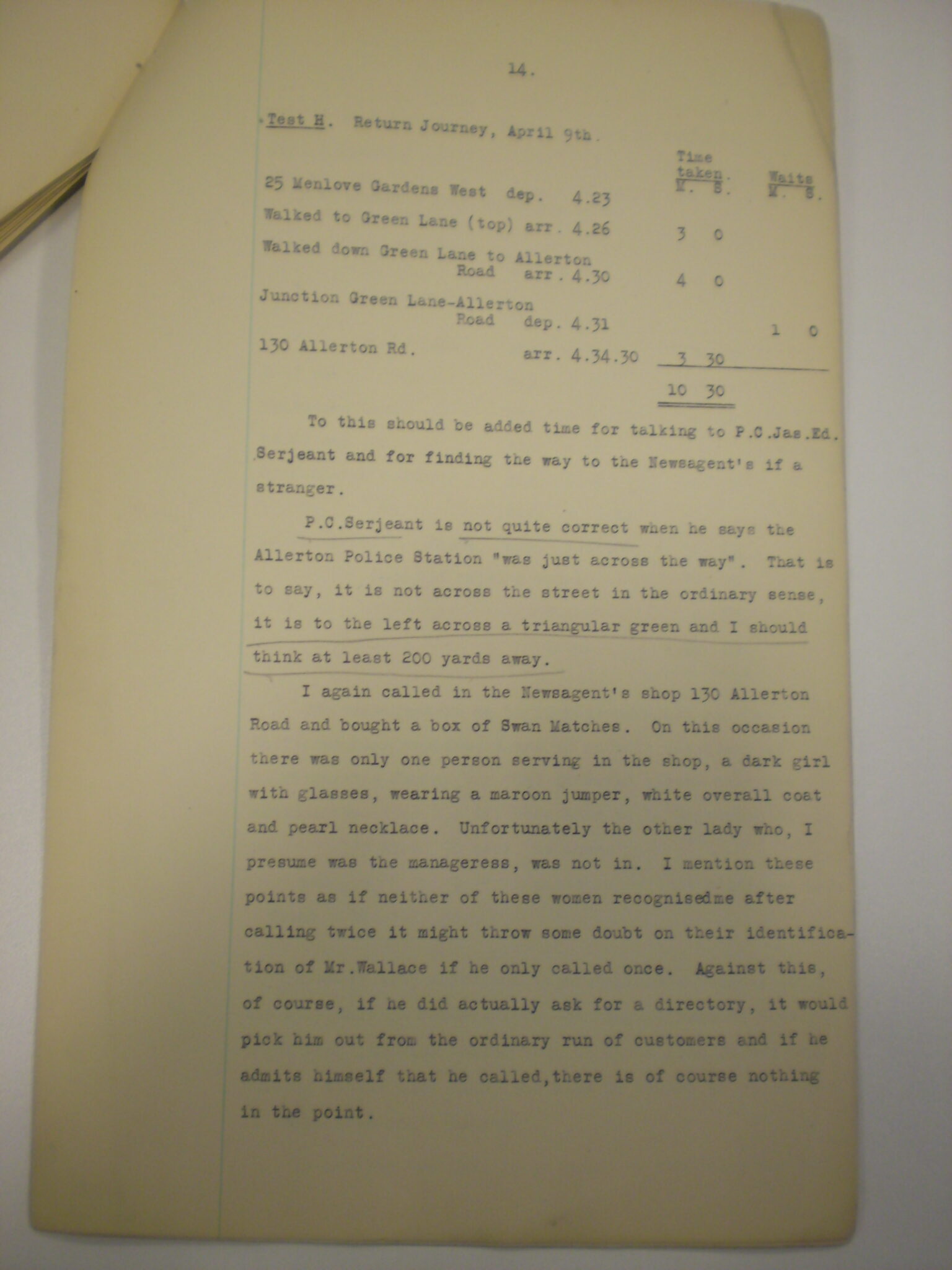
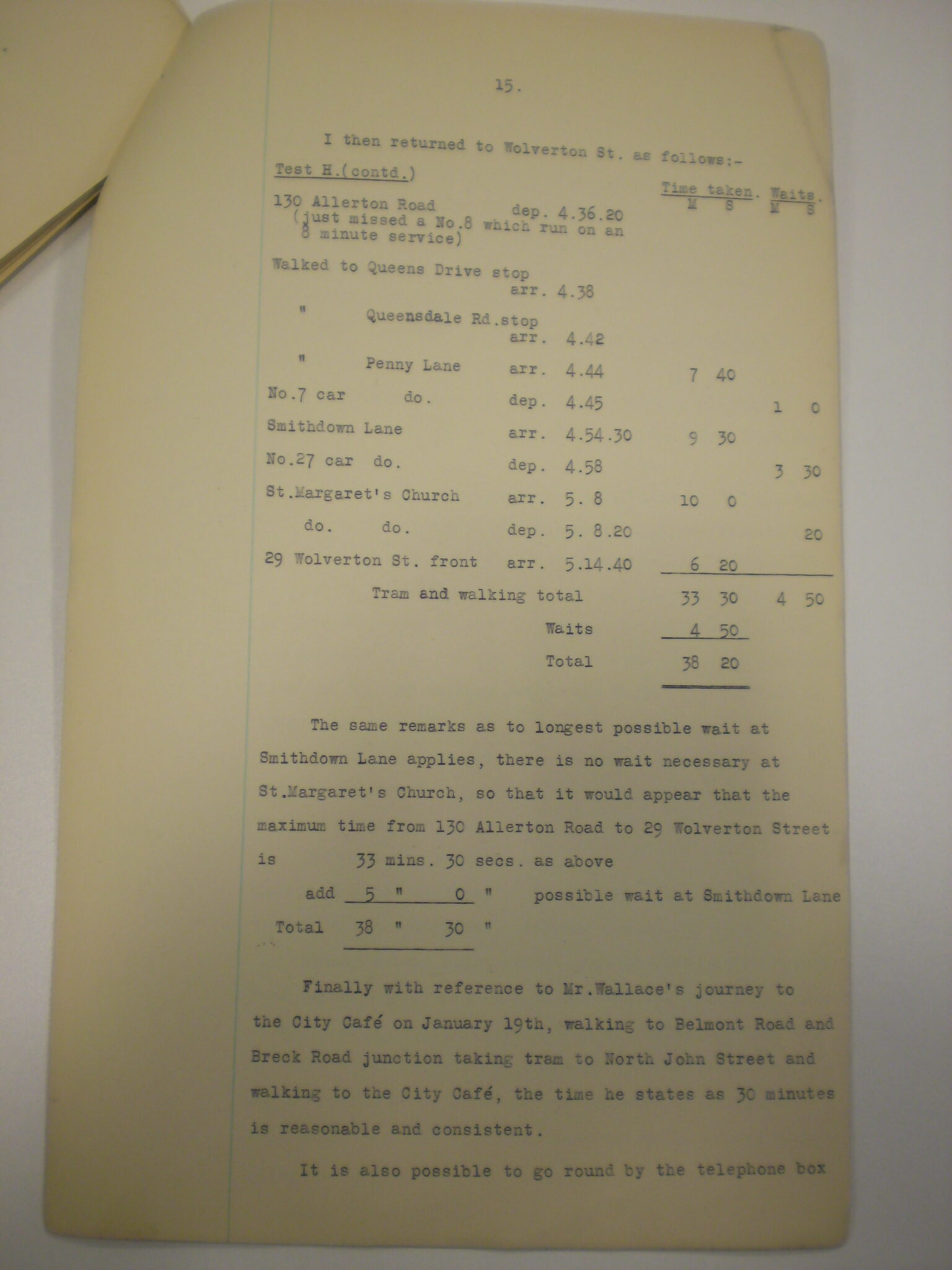
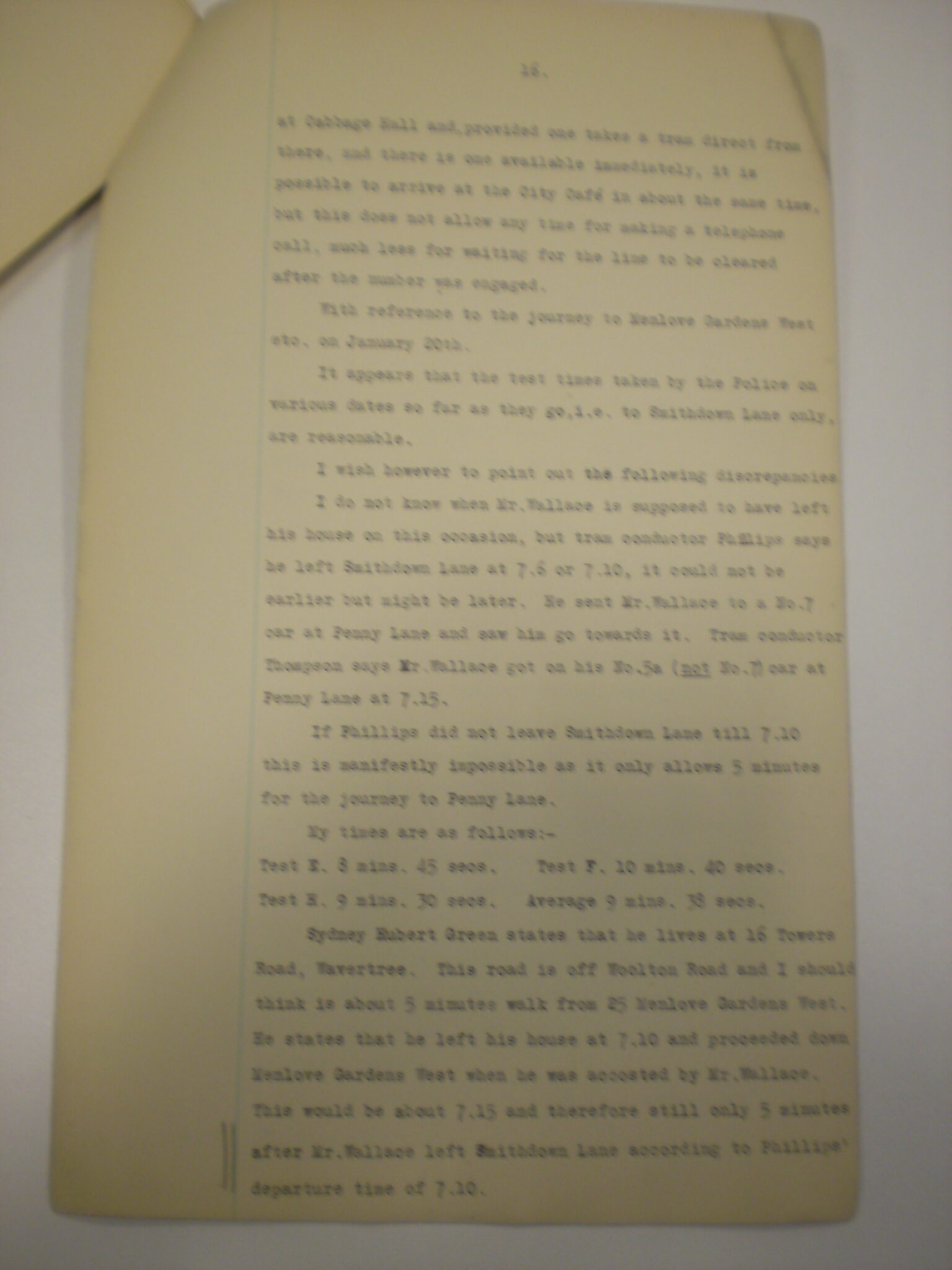
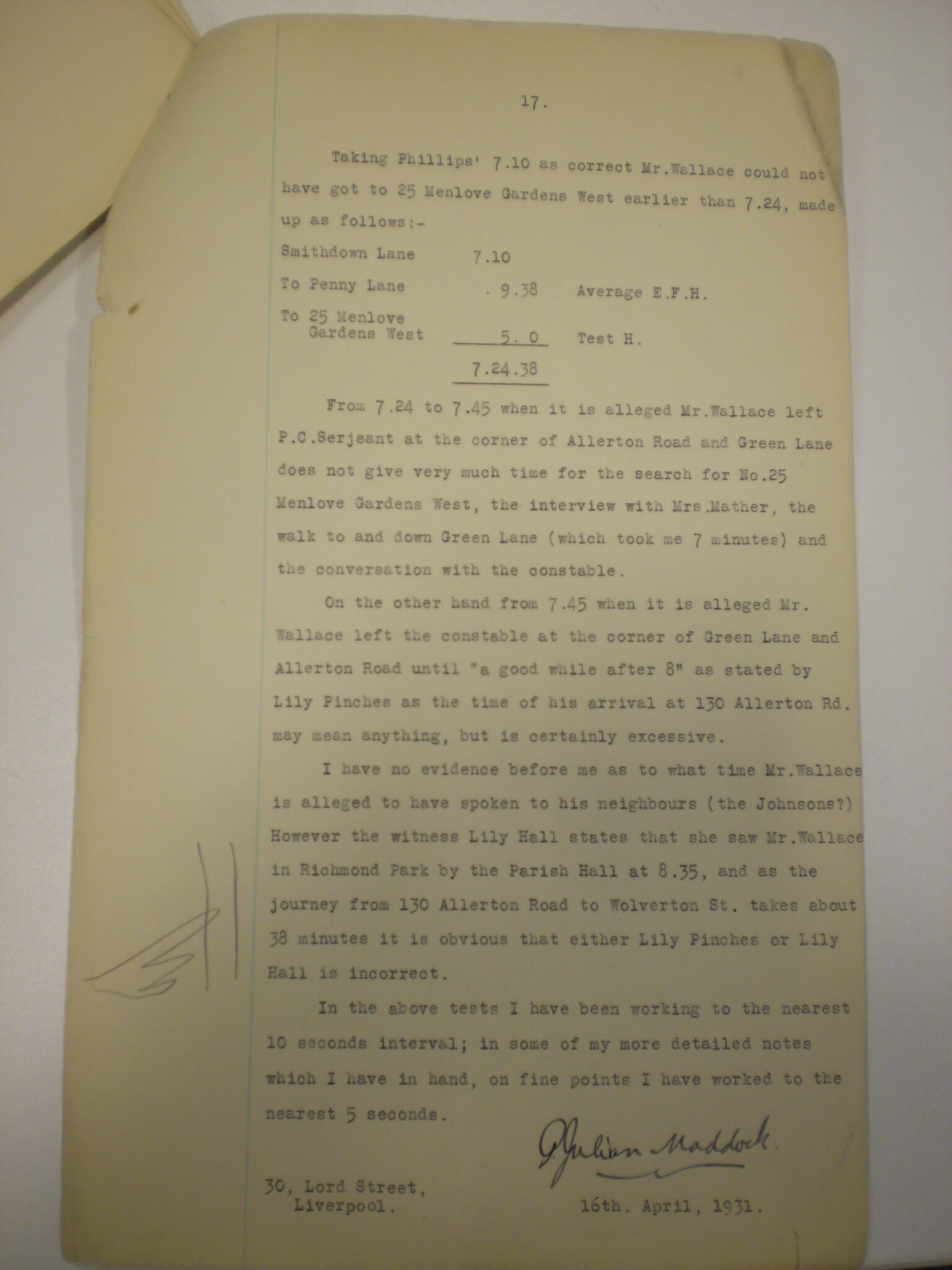
So the test from the call box to the chess club using Maddocks own timings are it could take as little as 24mins or as long as 33mins depending on how long the tram wait was at the corner of Townsend Lane.
We estimate the call ended at 7.27
The earlier wait sees W arrive at 7.51 and the later wait sees W arrive at 8pm so we can rule him out as the caller then once and for all as even given the latest estimates of W arrival – he says himself 7.50 and yet also he is seen about 7.50 playing his game (undoubtedly having already ascertained that his planned opponent Chandler wasn’t there)
It is clearer now why the prosecution didn’t use this against W at the trial. Did the defence have knowledge of it?
This information is inaccurate, it’s possible to make the call, walk to Belmont Road (not even board near the phone box), and arrive at the cafe at 7.50.
I’ve done off Maddocks times above.
It can take up to 33 minutes if you wait the full 9 for the next tram if having just missed one. If the call finishes at 7.27 as is likely given that Harley didn’t even speak to anyone until around 7.21-7.22 then that puts W in the cafe at 8pm which is ridiculous.
You haven’t, you are using the times which include with it the walking time to the stop for example. And 7.27 is not accurate information, 7.26 for example is with your longest call length estimate and 2 minute delay.
Right RMQ let me break it down for you as you have it wrong and in fact Antony Brown backs me up on the facebook site but Mike isn’t privy to that.
Maddocks TEST D
Arrives at the call box at 5.19 and gets to the club at 5.45 with a waiting time of 5.40.
The call lasts 7 mins from being eventually put through at 7.20 by the third operator Annie Robertson and for reasons given above previously under oath by Harley, Beattie etc, the call lasts until 7.27 (Harley doesn’t even go to Beattie until 7.22)
The min you can wait for a tram makes the phone box to cafe time 24 mins without the call time and the max you can wait for a tram makes the phone box to cafe time 33 mins without the call time. So this puts W arriving at the earliest 7.51 and at the latest 9 minutes later which is ridiculously 8pm. Little wonder then that the prosecution didn’t use anything of Maddocks. I wonder though if they made the findings available to the defence, not likely and they didn’t have to just like they didn’t make the findings of their interviews with the children available, much to Munros disgust.
Also, Roland Oliver asserts that the new style call box had a 60 candle power lamp which the hopeless and hapless telephone engineer Leslie Heaton 9not having done his one job) cannot confirm.
I don’t have it wrong.
The time taken in Test D is 20½ minutes: It’s 2 minutes to Belmont. 10 seconds waiting at Belmont inside the tram. 16’50” to the stop near the café from there. 1½ minute walk to the café.
The other tests from Belmont make 18¼ to 18¾ ish. This is the stop he claims to have used and he can make the club in the time window claimed even by this stop.
The call doesn’t last 7 minutes from 7.20. That is an invented fact and not even accurate by your provided skewed estimates (which made it 7.26 AKA 6 minutes from log time).
Maddock is the defence witness. The report is addressed to Munro as you will see.
Yes and as a defence witness do you think they would be publishing to the prosecution that Wallace could have done this 🙂
The call is put through at 7.20. Tell me when Gladys Harley first speaks with Q.
Have a similar conversation to what took place, allowing for going and fetching etc and see just how quickly 5, 6 or 7 minutes passes where you probably wouldn’t think you’ve been on the phone that long. Add to it all the palaver by the caller before Annie Robertson even puts him through and why would Wallace be doing that, it doesn’t even make sense. Parry on the other hand, a known phone box thief who likes to make calls for free and possibly isn’t even au fait with making paid calls from phone boxes (Atkinson’s garage) with time on his hands, well…..
Also RMQ you’ve swayed from one guilty party to the next so you can’t talk and also included things like spanners into the equation or other things to suit a certain agenda. Come on, even go with your gut sometimes, this isn’t Wallace who has no need or motive.
I’m trying to keep factual accuracy. I did test the conversation myself with a stopwatch, multiple times. Even when I was hoping for a certain result I couldn’t make it last as long as that. It just isn’t accurate.
The spanner comment was made to me years ago.
“The man had a deep voice and spoke very quickly” – Testimony of Gladys Harley. Speaking “very quickly” is a technique used to avoid voice recognition; one concentrates on catching what is being said rather than on the characteristics of the voice itself.
Ms Harley’s remark should be taken into account when estimating the duration of the call which incidentally I cannot believe lasted as long as seven minutes.
Whether Qualtrough wanted to get he call over quickly in order to get to the club on time or whether he habitually spoke rapidly is unknown.
Phone operators were used to some callers trying to scam a free call by claiming to have pressed Button A. The idea that anyone trying this, e.g. Parry, would always be put through free of charge is a myth. If that were the case lots of people would be at it.
Parry was a phone box cash thief but this has nothing to do with the Qualtrough call as the cash box was untouched.
Parry likes to scam free phone calls – we have only the ever-reliable John Parkes to thank for this information. Nobody else.
As regards “all the palaver” with different operators trying to make the connection and “why would Wallace do this?” It wasn’t Wallace’s or anyone else’s “doing.” It was the operators following normal procedure when a caller had difficulty with the connection. It was a glitch in the system, not uncommon in those early days, not an attempt to scam a free call.
It didn’t last 7 minutes, it last 5 as there was up to 2 minutes before Beattie spoke to Q. The spoke quickly is only noted by Harley, not by Beattie who says it wasn’t W, by then he could be speaking in a different voice as B describes it differently than the others. We can’t just pick the parts out that suit a certain agenda.
If Q is wanting to get the call over quickly in order to get to the club (IE Wallace) then why is he faffing about since 7.15 when the call originated? Is there any evidence from the telephone Engineer called that this was a glitch in the system?
Why do you describe Parkes as ‘only the ever reliable’ Mike. Why is he less reliable than say Lily Hall? or PC Rothwell who gives 2 different versions of how he saw W?
What has Parkes said he saw with his own eyes that wasn’t corroborated by the Atkinson’s?
Parkes’ story is corroborated by nobody (he was the only person there), and he gave no verifiable details whatsoever. Lily Hall gave accurate descriptions of Wallace’s outfit as described by other witnesses that night, and described seeing another man who matches a description of the man seen by Mr. Greenlees in that same street at the time.
Can you stop just making things up about the call ending at 7.27? It is literally invented in your head, evidently wrong, and I am trying to maintain a factually accurate account of case details.
If there are 2 minutes “faffing about” before Qualtrough speaks to Beattie then we are at 7.17 pm already. If, as you say Ged, their conversation lasts 5 minutes we are at 7.22 pm (not 7.27 pm) when Qualtrough hangs up .
I picked out Ms Harley’s remark about Qualtrough speaking quickly, not to fit a certain agenda, but because I thought it relevant for anyone e.g RMQ trying to reproduce and time the conversation.
I don’t think anyone was deliberately “faffing about” prior to being connected. It would be of no advantage to the caller whoever he was. In fact he is more likely to be remembered. When I use “glitch” I don’t mean a mechanical or electrical fault which an engineer would be able to identify. Just a bit of bad luck in not being connected for whatever reason the first time.
I completely agree with RMQ that Parkes’ story is not corroborated by anyone. The Atkinsons confirmed only that Parkes had told them his tale . This being the case, and due to the dramatic allegations made by Parkes I think his account is inherently unreliable.
Lily Hall’s sighting of the two men conversing is interesting but, unlike Parkes, hardly a silver bullet in the case whether we believe it or not.
He is saying from 7.20, there is 2 minutes of delay, then a 5 minute conversation. It is completely inaccurate and it is made up that the call ends at 7.27. I am not sure if this testimony is helpful:
“Did you get the call through? Yes.
Do you remember the time? About 20 minutes past seven.
…
And you put the caller through to the witness Kelly? Yes, the caller was put through at 7.20.”
Once the operator got a response from the cafe (i.e., not engaged), they kept Gladys on the line while telling the caller to insert his two pennies again etc.
And to complicate matters even further Annie Robertson at one point says “The call was through at 7.15.”
Like myself Judge Wright asked why a docket showing the time was necessary but all he got was essentially “We always do it for the record.”
As with many aspects of the Wallace case we have to allow for a certain error in recollections of time. Was the 7.20 pm recorded precisely when the call was put through or somewhat later? And of course we do not know for certain when Wallace arrived at the chess club – our best guess is 7.45 to 7.50 pm. Allowing for these uncertainties I do believe he could have been caller.
If I had to guess, I would have thought the supervisor would actually stay on the line until she confirmed the caller had been put through. When a note was made I am not sure. But Wallace arriving between 7.45 and 7.50, it is possible to walk down to Belmont Road and catch a tram even if the phone goes down at 7.27 (he can walk over to Belmont, 523 yards, in 4½ to 5¼ minutes-ish if he walks a bit over average pace: 3.5 to 4 mph). If he stepped onto a tram as he arrived, even with this incorrect call duration, it can be done.
Math attempts like Antony M. Brown’s tram time calculations don’t take into account important real world elements. For example, there isn’t a random amount of wait time at each stop, the tram will turn up when it turns up. E.g. if a tram is scheduled for 7.30, regardless of when he gets to that stop, it will arrive at 7.30. Whether he got there at 7.27, 7.28, 7.29, or 7.30, the tram is going to be there at the same time.
Put simply it’s like catching a train, you either get there in time and board, or you miss it and have to take the next.
There are stops along the way and it is a long straight road. Which means as you walk, you could glance back and see if there is a tram coming in the distance.
Even a man who is innocent seems unlikely to walk past a stop if the tram he wants to catch is already there. So we should be able to determine that the tram was not at Richmond Park or Newcombe as he passed them. So by the time he reaches Belmont Road, a tram should be due quite shortly.
These are very good points. Particularly your finding that even with a 7.27 pm hang-up, Wallace could have walked to the Belmont Road tram stop and still arrived at the club around 7.45 – 7.50. I have always kept away from discussions on tram timings etc as I don’t have any knowledge of the local geography so I leave it to those who do.
Well I don’t know the geography well I’m using the times on this page, but it’s 18½ minutes from Belmont tram stop to the cafe. It’s 523 yards from the call box to this tram stop, regularly it would be about 6 minutes walking, so 24 minutes after the phone goes down would be the minimum. If it went down at 7.27, he arrives about 7.51.
However, if you walk a little more than average pace, you can do the walk to Belmont in about 4½ minutes (4 mph). Average walking speed for an average height man would be 3 mph. Wallace is very tall, bigger stride length, I would imagine walking over average pace would be quite easy if he was trying. And this would make the trip still possible.
CalculatorSoup has a pace calculator where you can check the walking speed and time it would take to cover 523 yards on foot.
Granted that he could have boarded the tram at the Belmont Road stop, as he claimed to have done. But if he never thought the call would be traced, why would he walk the 523 yards to Belmont instead of boarding at the stop 25 yards from the call box?
Possibilities are:
Old habits ….. to save money on the fare.
Avoiding the possibility of being seen boarding the tram near a call box.
The chance of meeting Mr Caird who would support his tale of boarding at Belmont just in case the call was traced.
But if he considered for a minute that the call might be traced he would surely have chosen a call box well away from Wolverton Street….
This is overstated. It isn’t unusual to try to place yourself away from things used in the commissioning of a murder. This is the only route he gives where he provides himself with an “out” by saying he only “thinks” he took this route and “thinks” he “may have” stopped to mail a letter.
The phone didn’t go down at 7.27 that’s invented, it is just that it is still possible to make the trip in this invented time even from Belmont Road, without jogging. It has been tested. If you walk 4 mph you can make 7.50 from Belmont Road even if you placed the phonecall. He says he arrived at the club “around 7.50” not that he was in a game at 7.50.
Incidentally, I have a suspicion he boarded at Richmond Park near the postbox where he says he mailed a letter, and that he brought up mailing the letter as a possible explanation for boarding there if he had been seen. The library and post box is close to this stop.
By the times provided it is easily possible for him to make the call and arrive at the club by the stops nearer the box, and possible EVEN IF he walked all the way to Belmont. It is also possible for him to kill his wife after the milk boy leaves and board the 7.06 tram at Smithdown.
I have a very good knowledge of the area, terrain (Uphill) and distances involved and let me say that if the phone went down around 7.27 there is no way imho, particularly with a tram diversion and the congestion even that that diversion may also create with everyone having to use a diversion route that Wallace would be sitting playing a game of chess in the city centre at 7.50 latest. You are also going off the minimum waiting times and a decently fast walking time.
Good point Mike about why W would walk all the way up to Belmont Road from the phone box in the first place when there is one just there closer. Something i’ve said all along and the answer always given that he would use the Townsend Lane one but that is far too risky – as imho using a lit phone box and Roland Oliver does seem to have done his homework on this and it was not contested by the hapless engineer who should have checked this fact out. I wonder if the police did and found it to be lit which went against their idea but again said nothing.
If Wallace is guilty then the time he claims to have arrived at the chess club (~7,50 pm) should be treated with suspicion that it might be a self-serving lie giving him a tight time window to get to the club after speaking with Mr Beattie. But this depends on the call being traced and timed – a possibility which I don’t think Wallace had considered, otherwise he would have used a phone box far from his neighbourhood.
So it is likely to be Wallace’s genuine recollection of the time he arrived. As such, it can only be an approximation which may be several minutes either side of the true time. He had no particular reason to clock his arrival time and “around 7.50 pm” is his “best guess.”
We have, as so often in this case, to ask ourselves how accurately we can recall the time we sat down to dinner last night, or exactly what time we arrived home. These are everyday events and we have no reason to record their timing with absolute precision. Accordingly, I agree that Wallace could have made the Qualtrough call and been at the club by his claimed “around 7.50 pm.”
There is no evidence that by 7.50 pm Wallace had arrived, hung up his coat/hat, refused the offer of a game from Mr Caird because of his scheduled match with Chandler, looked around for Mr Chandler, satisfied himself that Chandler was absent and due to the hour was unlikely to appear, agreed to have a game with Mr McCartney and was seen (by whom?) to be busy with this game at 7.50 pm.
I would imagine multiples of ten (like “7.50”) would be more likely accurate than quarter hours (7.15, 7.30, 7.45). Usually people use rounder and rounder figures the less certain they are. 7.50 would generally be stated by someone who had a more accurate idea of what time the event took place. Another example being Wildman’s seeing of the church clock at 7.35.
I agree with RMQ here. It wasn’t a quarter time provided, it was more precise than that and 3 people mentioned 7.50. Caird (Beattie as in not before) and of course W himself.
Excuse my lack of knowledge of the tram route. But if Wallace boarded the tram at any stop before the tram reached Belmont Road didn’t he run the risk of being seen by Mr Caird if he (Caird) boarded Wallace’s tram at Belmont Road. This would register with Caird as unusual and is likely to be remembered.
Caird went to the chess club from his shop, not from his home near Wolverton Street.
Michael, this is just one of the reasons I think it would be risky W using a different alighting point than usual. Caird, a driver, clippy, inspector, client or stranger to W could easily call him out as not having got on at Belmont Road.
Something else I found out yesterday that is interesting. All trams from Cabbage Hall had to time stamp their arrival at Eastbourne Street, Everton at a time clock situated there. It took 9 minutes for the tram to transit from Cabbage Hall to Eastbourne st and if only we knew the time stamp of W’s tram, because if it was pre 7.30pm then that would put him in the clear. Even so, a post 7.30 doesn’t draw any conclusion. Also I wonder if W was ever asked did he retain any of his tram tickets.
”Caird went to the chess club from his shop, not from his home near Wolverton Street.”
Would Wallace know this though? Would Wallace know Caird or indeed anyone else would not see him and blow him up.
Where was Caird’s shop?
Elsewhere (it’s in his statement I think?), he didn’t take the same tram as the wife murderer on the journey to the club.
Caird’s shop: 113 Stanley Road. If I’m reading Caird’s statement correctly he doesn’t say how he got to the chess club on the Monday. He does say he saw Wallace arrive at the club but the time isn’t given so he arrived before Wallace.
In his statement Caird said he suggested Wallace take a Queen’s Road bus to Menlove Gardens but Wallace said he would take a tram into town because HE KNEW THAT WAY
So we have it from Wallace’s own lips that he was familiar with the first part of the trip so why did he enquire so persistently of the tram conductors if he was already familiar with the route?.
It’s a throw away remark, he didn’t even go into town. His familiar route to Crewe’s house at Green Lane was a different route along Allerton Road, not Menlove Avenue. Only when you walk the length of Green Lane as I have done with the other enthusiasts you realise the length of it and you cannot see one end from the other, especially in the dark. Crewe lived a little closer to the Allerton Road end so that would be the way to go.
I have said it before, for 20 years I went to Goodison Park to watch Everton. There were a few routes I could take, ask me to name all the roads off Goodison road back then or even now and I couldn’t tell you.
Michael, Caird does mention Wallace’s arrival time:
”On Monday 19th January last I arrived at the City Café, North John Street, Liverpool at about twenty five to eight. I had a look round to see if there was anybody to play, but as there (was) nobody with whom I was paired I strolled round & had a look at the games. While doing so, I saw Mr Wallace, who had just come in, with his hat & coat on. It was then about a quarter to eight.”
Fair enough Ged. Good points. By the way with your knowledge of Liverpool: does the address of Caird’s shop make it more convenient for him to go direct to the chess club rather than going home first?
Hi Michael. 113 Stanley road is in the Liverpool district of Kirkdale between Great Mersey street and Evelyn street. There is a straight tram route using the Seaforth or Litherland or Bootle to City Centre route without going anywhere near the Wolverton street area. It depends of course if he shut up shop at say 7pm and went direct to North John street or if he closed at 5pm and then went home first.